Paul van Yperen's Blog, page 314
March 24, 2017
Carte Blanche for Everything Croton
Everything Croton is a blog that reports on local issues in the village of Croton-on-Hudson, New York. But editor Maria also loves all things vintage and at least a third of the posts are reserved for movies, vintage Christmas, history, antiques, and such. We gave Maria carte blanche for this guest post and she chose some of her favourite EFSP posts, some with a 'Croton-on-Hudson' connection.
Imported from the USA: Gloria Swanson
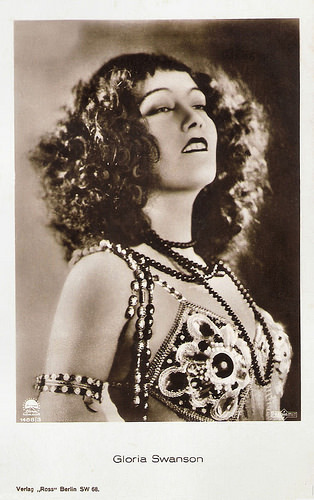
German postcard by Ross Verlag, no. 1488/3, 1927-1928. Photo: Paramount / Parafumet. Publicity still for Stage Struck (Allan Dwan, 1925).
Maria: "Swanson lived in Croton-on-Hudson in the 1920s. You can read more about that here."
Erich von Stroheim
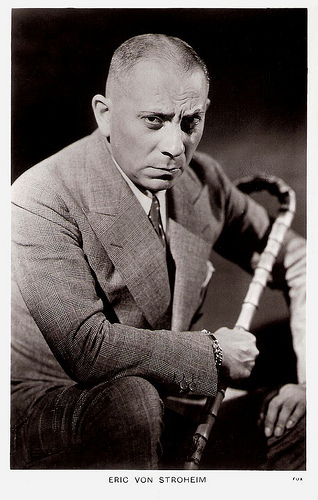
British postcard in the Picturegoer series, London, no. 20a. Photo: Fox.
"Erich von Stroheim, a most talented director and actor, rumored—but never confirmed--to have spent time in Croton at the Swanson estate."
Ben-Hur: A Tale of the Christ (1925)

German postcard by Ross-Verlag, no. 133/3. Photo: Metro-Goldwyn-Mayer. Publicity still for Ben-Hur (Fred Niblo, 1925) with Messala (Francis X. Bushman) and Ben-Hur ( Ramon Novarro ) during the famous chariot race. Mark how the tribunes are empty and the upper part of the circus is missing (it was projected into the film using a hanging model).
"Former matinee idol Francis X. Bushman also had a Croton-on-Hudson connection."
Charles Chaplin
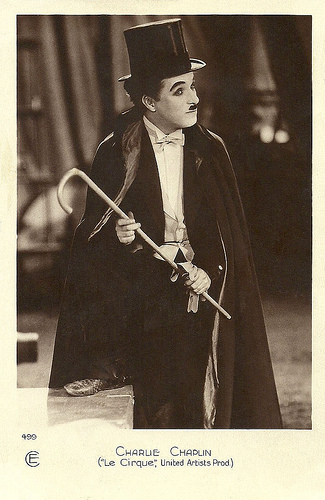
French postcard by Editions Cinematographiques, no. 499. Photo: United Artists. Publicity still for The Circus (1928). Collection: Didier Hanson.
Chaplin (1992)
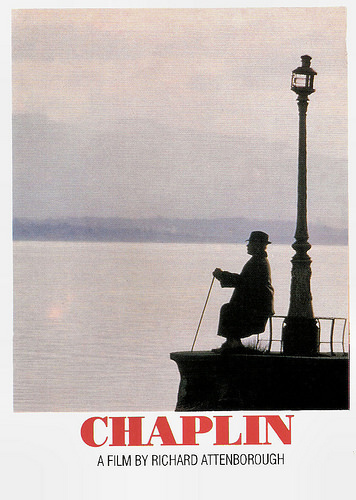
French postcard by Editions Mercuri, no. 813. Photo: Tri-Star Pictures. Publicity still for Chaplin (Richard Attenborough, 1992), which featured Robert Downey Jr. as Charles Spencer Chaplin.
"Chaplin also had a Croton connection to the editor of The Masses, Max Eastman."
Our Gang's Jean Darling and Dickie Moore R.I.P.
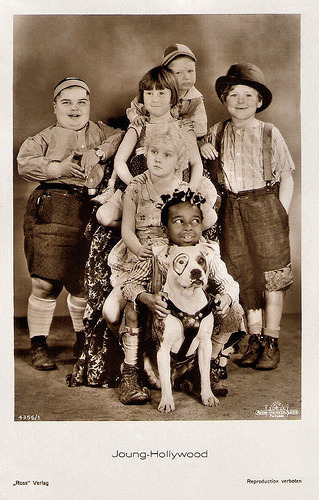
German postcard by Ross Verlag, no. 4356/1, 1929-1930. Photo: Metro-Goldwyn-Mayer. Publicity still of Our Gang a.k.a. The Little Rascals with Jean Darling, the blonde girl.
"The Little Rascals post from EFSP - because they still have lots of fans here in Croton!"
Merry Christmas!
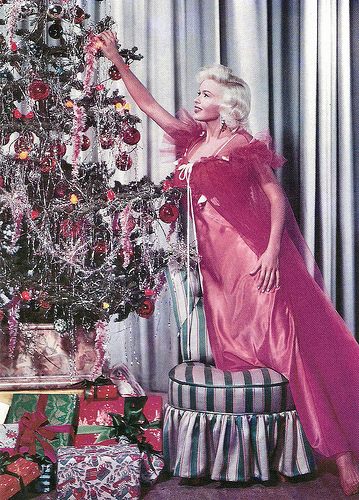
Jayne Mansfield . French postcard by Edition Humour a la carte. Photo: Filmhistorisches Bildarchiv Peter W. Engelmeier.
"The 2016 EFSP Merry Christmas post."
Thank you Maria, and greetings from us here at EFSP to everybody in Croton!
Imported from the USA: Gloria Swanson

German postcard by Ross Verlag, no. 1488/3, 1927-1928. Photo: Paramount / Parafumet. Publicity still for Stage Struck (Allan Dwan, 1925).
Maria: "Swanson lived in Croton-on-Hudson in the 1920s. You can read more about that here."
Erich von Stroheim

British postcard in the Picturegoer series, London, no. 20a. Photo: Fox.
"Erich von Stroheim, a most talented director and actor, rumored—but never confirmed--to have spent time in Croton at the Swanson estate."
Ben-Hur: A Tale of the Christ (1925)

German postcard by Ross-Verlag, no. 133/3. Photo: Metro-Goldwyn-Mayer. Publicity still for Ben-Hur (Fred Niblo, 1925) with Messala (Francis X. Bushman) and Ben-Hur ( Ramon Novarro ) during the famous chariot race. Mark how the tribunes are empty and the upper part of the circus is missing (it was projected into the film using a hanging model).
"Former matinee idol Francis X. Bushman also had a Croton-on-Hudson connection."
Charles Chaplin

French postcard by Editions Cinematographiques, no. 499. Photo: United Artists. Publicity still for The Circus (1928). Collection: Didier Hanson.
Chaplin (1992)

French postcard by Editions Mercuri, no. 813. Photo: Tri-Star Pictures. Publicity still for Chaplin (Richard Attenborough, 1992), which featured Robert Downey Jr. as Charles Spencer Chaplin.
"Chaplin also had a Croton connection to the editor of The Masses, Max Eastman."
Our Gang's Jean Darling and Dickie Moore R.I.P.

German postcard by Ross Verlag, no. 4356/1, 1929-1930. Photo: Metro-Goldwyn-Mayer. Publicity still of Our Gang a.k.a. The Little Rascals with Jean Darling, the blonde girl.
"The Little Rascals post from EFSP - because they still have lots of fans here in Croton!"
Merry Christmas!

Jayne Mansfield . French postcard by Edition Humour a la carte. Photo: Filmhistorisches Bildarchiv Peter W. Engelmeier.
"The 2016 EFSP Merry Christmas post."
Thank you Maria, and greetings from us here at EFSP to everybody in Croton!
Published on March 24, 2017 23:00
March 23, 2017
Macha Méril
In the early 1960s, French actress and writer Macha Méril (1940) was one of the actresses of the Nouvelle Vague. During her career, she appeared in 125 films by such famous directors as Jean-Luc Godard, Luis Bunuel, Rainer Werner Fassbinder, and Dario Argento.
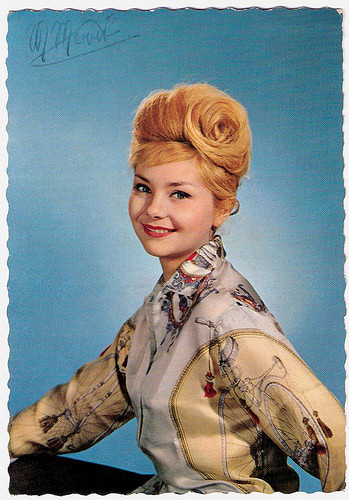
French postcard by E.D.U.G., no. 88. Photo: Lucienne Chevert.
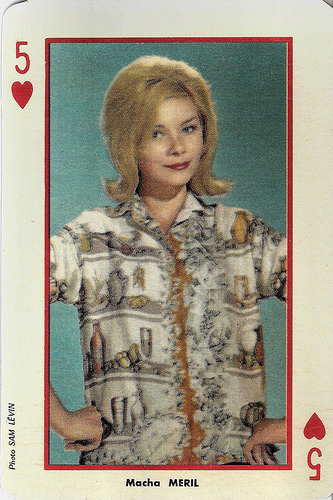
French playing card. Photo: Sam Lévin.
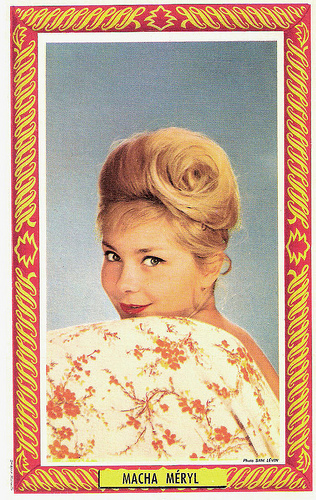
French postcard by St. Anne, Marseille. Photo: Sam Lévin.
Russian Princess
Macha Méril (sometimes written as Méryl) was born Princess Maria-Magdalena Vladimirovna Gagarina in 1940 in Rabat, Morocco. By her father, she is descended from the Russian princely house Gagarin and by her mother from a Ukrainian noble family. Her parents were Mary Belsky and Prince Belsky Wladimir Gagarin who were cousins and were found in the south of France after fleeing the Bolshevik Russia, separately.
She attended Lycce Marie Curie de Sceaux school, then started a degree in literature at the Sorbonne while attending the Course Dullin theatre NPT (Theatre National Populaire). From 1959 on, Macha Méril appeared in more than 125 films. She began her film career with a role in La Main chaude (1959), the directing debut of Gérard Oury. I
In the 1960s she also worked as a model. Between 1960 and 1962, she attended the course of Lee Strasberg at the Actor's Studio as an observer while working as a model in for Harper's Bazaar in New York. After a few guest parts in American TV series, she returned to France.
Her first French films were often examples of the Nouvelle Vague, like Eric Rohmer’s Le signe du lion/Sign of the Lion (1962). She also appeared in the double film La vie conjugale/Anatomy of a Marriage (André Cayatte, 1963), the story of a couple from the very first meeting to break up, told in one film from the perspective of the woman ( Marie-José Nat ) and in the other from the man ( Jacques Charrier ).
In Jean-Luc Godard’s Une femme mariée/A Married Woman (1964) she plays a bored housewife who has an affair. Godard records 24 hours in the life of Charlotte (Meril), the eponymous married woman, a morning and the morning after with her lover, actor Robert (Bernard Rose), the evening spent with Pierre, her pilot husband (Philippe Leroy).
Another highlight was the classic Belle de jour (Luis Bunuel, 1967), featuring Catherine Deneuve . She then formed her own production company called Machafilm which co-produced the romantic drama Au pan coupé/Wall Engravings (Guy Gilles, 1968), Pier Paolo Pasolini's Porcile (1969) and Robert Bresson’s Quatre nuits d'un rêveur/Four Nights a Dreamer (1971).
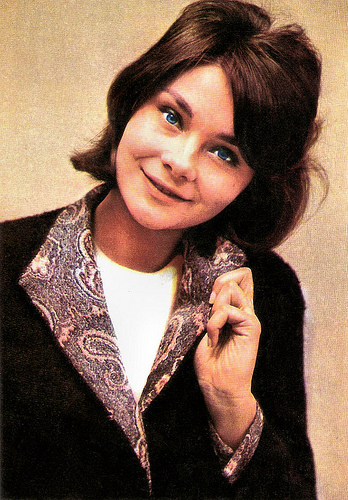
Romanian postcard by Casa Filmului Acin.
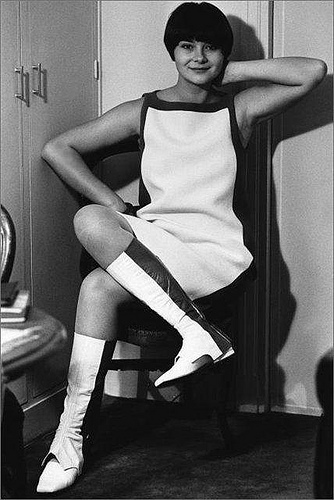
Collection: Bunched Undies.
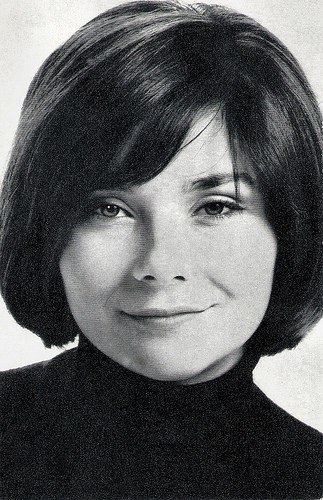
Romanian postcard by Casa Filmului Acin, no. 180.
Italian Horror Thrillers
In 1969, Macha Méril married Italian filmmaker and producer Gian Vittorio Baldi, and the couple settled in Rome. She kept appearing in interesting films, such as in the French film Nous ne vieillirons pas ensemble/Break-Up (Maurice Pialat, 1972) with Marlène Jobert and Jean Yanne.
She also often performed on TV. But Macha Méril is perhaps best known for her roles in the Giallos (Italian horror thrillers) Profondo rosso/Deep Red (Dario Argento, 1975) starring David Hemmings, and L'ultimo treno della notte/Night Train Murders (Aldo Lado, 1975), in which she played a demented nymphomaniac.
With her friend Anna Karina , she appeared in Rainer Werner Fassbinder’s Chinesisches Roulette/Chinese Roulette (1976). Back in France she appeared in the excellent thriller Mortelle randonnée (Claude Miller, 1983) starring Michel Serrault and Isabelle Adjani .
One of her best films is Agnes Varda’s dark but mesmerizing drama Sans toit ni loi/Vagabond (1985) with Sandrine Bonnaire as a free-spirited drifter on the road in southern France. Her later films include the drama Duet for One (Andrey Konchalovskiy, 1986) with Julie Andrews , the Italian drama Una storia semplice/A Simple Story (Emidio Greco 1991) starring Gian Maria Volonté, and the satire Meeting Venus (Istvan Szabo, 1991) with Meryl Streep.
Macha Méril has also written a series of cookbooks and four novels. She is politically active and has supported the presidential campaigns of Lionel Jospin in 2002, Ségolène Royal in 2007 and François Hollande in 2012. Between 1969 and 1978, she was married to Italian director and producer Gian Vittorio Baldi.
Since 2014, she is married to composer Michel Legrand. She has been given the Officier des Arts et des Lettres, Chevalier de l'Ordre du Merite, Chevalier de la Legion d'Honneur and Chevalier du Mérite Agricole. Her latest film is Un profil pour deux (Stéphane Robelin, 2017) with Pierre Richard .
Trailer Une femme mariée/A Married Woman (1964). Source: precija (YouTube).
Trailer Profondo rosso/Deep Red (1975). Source: Blade in the Dark (YouTube).
Trailer L'ultimo treno della notte/Night Train Murders (1975). Source: BlueUndergroundinc (YouTube).
Sources: Wikipedia and .

French postcard by E.D.U.G., no. 88. Photo: Lucienne Chevert.

French playing card. Photo: Sam Lévin.

French postcard by St. Anne, Marseille. Photo: Sam Lévin.
Russian Princess
Macha Méril (sometimes written as Méryl) was born Princess Maria-Magdalena Vladimirovna Gagarina in 1940 in Rabat, Morocco. By her father, she is descended from the Russian princely house Gagarin and by her mother from a Ukrainian noble family. Her parents were Mary Belsky and Prince Belsky Wladimir Gagarin who were cousins and were found in the south of France after fleeing the Bolshevik Russia, separately.
She attended Lycce Marie Curie de Sceaux school, then started a degree in literature at the Sorbonne while attending the Course Dullin theatre NPT (Theatre National Populaire). From 1959 on, Macha Méril appeared in more than 125 films. She began her film career with a role in La Main chaude (1959), the directing debut of Gérard Oury. I
In the 1960s she also worked as a model. Between 1960 and 1962, she attended the course of Lee Strasberg at the Actor's Studio as an observer while working as a model in for Harper's Bazaar in New York. After a few guest parts in American TV series, she returned to France.
Her first French films were often examples of the Nouvelle Vague, like Eric Rohmer’s Le signe du lion/Sign of the Lion (1962). She also appeared in the double film La vie conjugale/Anatomy of a Marriage (André Cayatte, 1963), the story of a couple from the very first meeting to break up, told in one film from the perspective of the woman ( Marie-José Nat ) and in the other from the man ( Jacques Charrier ).
In Jean-Luc Godard’s Une femme mariée/A Married Woman (1964) she plays a bored housewife who has an affair. Godard records 24 hours in the life of Charlotte (Meril), the eponymous married woman, a morning and the morning after with her lover, actor Robert (Bernard Rose), the evening spent with Pierre, her pilot husband (Philippe Leroy).
Another highlight was the classic Belle de jour (Luis Bunuel, 1967), featuring Catherine Deneuve . She then formed her own production company called Machafilm which co-produced the romantic drama Au pan coupé/Wall Engravings (Guy Gilles, 1968), Pier Paolo Pasolini's Porcile (1969) and Robert Bresson’s Quatre nuits d'un rêveur/Four Nights a Dreamer (1971).

Romanian postcard by Casa Filmului Acin.

Collection: Bunched Undies.

Romanian postcard by Casa Filmului Acin, no. 180.
Italian Horror Thrillers
In 1969, Macha Méril married Italian filmmaker and producer Gian Vittorio Baldi, and the couple settled in Rome. She kept appearing in interesting films, such as in the French film Nous ne vieillirons pas ensemble/Break-Up (Maurice Pialat, 1972) with Marlène Jobert and Jean Yanne.
She also often performed on TV. But Macha Méril is perhaps best known for her roles in the Giallos (Italian horror thrillers) Profondo rosso/Deep Red (Dario Argento, 1975) starring David Hemmings, and L'ultimo treno della notte/Night Train Murders (Aldo Lado, 1975), in which she played a demented nymphomaniac.
With her friend Anna Karina , she appeared in Rainer Werner Fassbinder’s Chinesisches Roulette/Chinese Roulette (1976). Back in France she appeared in the excellent thriller Mortelle randonnée (Claude Miller, 1983) starring Michel Serrault and Isabelle Adjani .
One of her best films is Agnes Varda’s dark but mesmerizing drama Sans toit ni loi/Vagabond (1985) with Sandrine Bonnaire as a free-spirited drifter on the road in southern France. Her later films include the drama Duet for One (Andrey Konchalovskiy, 1986) with Julie Andrews , the Italian drama Una storia semplice/A Simple Story (Emidio Greco 1991) starring Gian Maria Volonté, and the satire Meeting Venus (Istvan Szabo, 1991) with Meryl Streep.
Macha Méril has also written a series of cookbooks and four novels. She is politically active and has supported the presidential campaigns of Lionel Jospin in 2002, Ségolène Royal in 2007 and François Hollande in 2012. Between 1969 and 1978, she was married to Italian director and producer Gian Vittorio Baldi.
Since 2014, she is married to composer Michel Legrand. She has been given the Officier des Arts et des Lettres, Chevalier de l'Ordre du Merite, Chevalier de la Legion d'Honneur and Chevalier du Mérite Agricole. Her latest film is Un profil pour deux (Stéphane Robelin, 2017) with Pierre Richard .
Trailer Une femme mariée/A Married Woman (1964). Source: precija (YouTube).
Trailer Profondo rosso/Deep Red (1975). Source: Blade in the Dark (YouTube).
Trailer L'ultimo treno della notte/Night Train Murders (1975). Source: BlueUndergroundinc (YouTube).
Sources: Wikipedia and .
Published on March 23, 2017 23:00
March 22, 2017
La grande passione (1922)
The silent Italian drama La grande passione (1922) was a star vehicle for diva Italia Almirante Manzini. The film was directed by her cousin Mario Almirante. He also wrote the script, based on a novel by writer-reporter Alessandro Varaldo. Cinematography was by Ubaldo Arata, and the sets were designed by Mario Gheduzzi. The film was produced by Produzione Fert (Rome-Turin). In 2001 a restored print of the Filmoteca de la UNAM (Mexico) was presented at Cinema Ritrovato festival in Bologna.
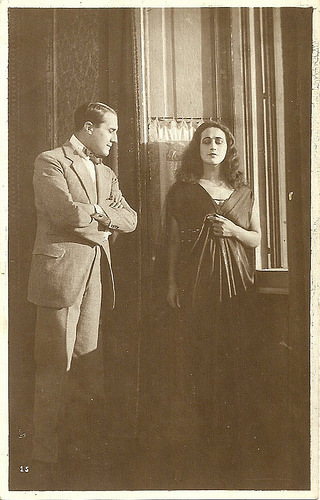
Italian postcard, no. 15. Photo: Società cinematografica FERT. Publicity still for La grande passione (Mario Almirante, 1922), starring Italia Almirante Manzini and here with Carlo Benetti. Caption: If you decide to accept we could take the 19:00 train. Think about this when you have calmed down.

Italian postcard, no. 16. Photo: Società cinematografica FERT. Publicity still for La grande passione (Mario Almirante, 1922). Caption: After the duel in American style.
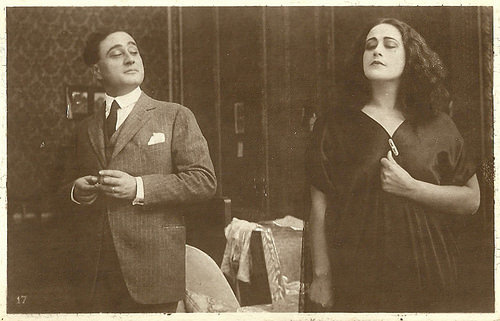
Italian postcard, no. 17. Photo: Società cinematografica FERT. Publicity still for La grande passione (Mario Almirante, 1922), starring Italia Almirante Manzini and Carlo Benetti. Caption: Oh? Dignity?... Which one?
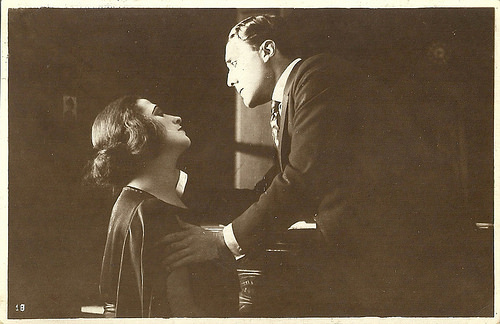
Italian postcard, no. 18. Photo: Società cinematografica FERT. Publicity still for La grande passione (Mario Almirante, 1922). Caption: My dear, I understand you and I love you.
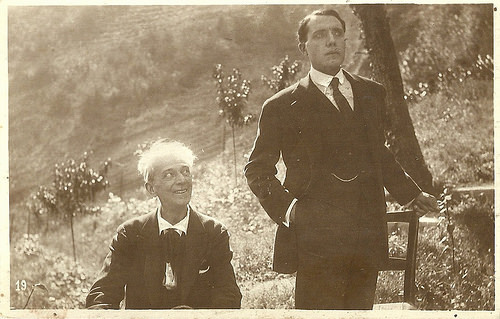
Italian postcard, no. 19. Photo: Società cinematografica FERT. Publicity still for La grande passione (Mario Almirante, 1922). Caption: Patrizio Algesio and Gaspare Lucidi.
Not love but serenity
La grande passione (1922) tells the story of Maria (Italia Almirante Manzini), an orphan, who lives with her uncle (Vittorio Pieri). Her beauty raises the jealousy of her female cousins, who persecute her.
Maria is almost obliged to accept a marriage offer by a rich widower, Carli (Joaquin Carrasco). It is not love but serenity. Love appears as another man, Marcello (Carlo Benetti), cousin of Carli, starts to court Maria. A friend, Patrizio ( André Habay ), warns her in vain.
After being left by Marcello, Maria accepts the sincere and disinterested love of Patrizio. When Marcello returns and wants Maria back, a duel with Patrizio follows in which Marcello is killed. In the meantime Carli has been ruined by Marcello. It is then that Maria understands her plight to stay close to her husband, sacrificing her great love for Patrizio, while returning to Carli.
When La grande passione was released in Italy in early 1923 it was praised by the Italian trade press. Both La vita cinematografica and La rivista cinematografica lauded both Mario Almirante's direction and Italia Almirante 's dramatic performance.
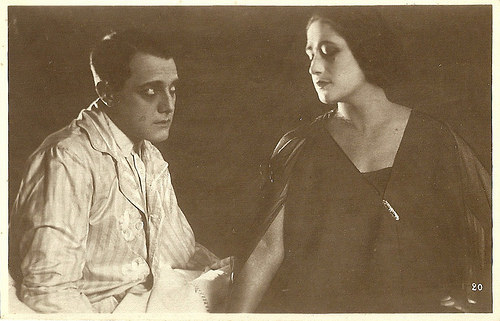
Italian postcard, no. 20. Photo: Società cinematografica FERT. Publicity still for La grande passione (Mario Almirante, 1922), starring Italia Almirante Manzini and André Habay . Caption: You are still decided to never leave me.
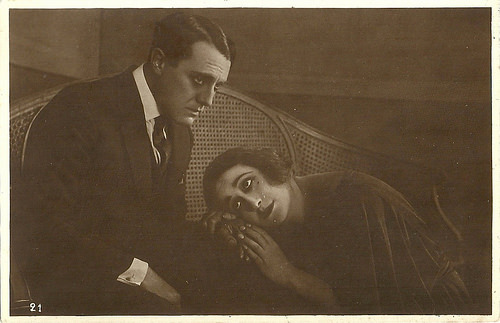
Italian postcard, no. 21. Photo: Società cinematografica FERT. Publicity still for La grande passione (Mario Almirante, 1922), starring Italia Almirante Manzini and André Habay . Caption: Caption: The past.
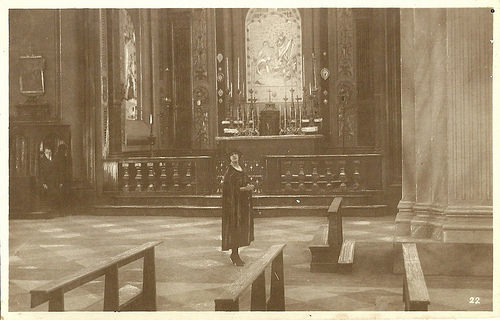
Italian postcard, no. 22. Photo: Società cinematografica FERT. Publicity still for La grande passione (Mario Almirante, 1922), starring Italia Almirante Manzini . Caption: Separation.

Italian postcard, no. 23. Photo: Società cinematografica FERT. Publicity still for La grande passione (Mario Almirante, 1922), starring Italia Almirante Manzini and André Habay . Caption: It's about to leave!
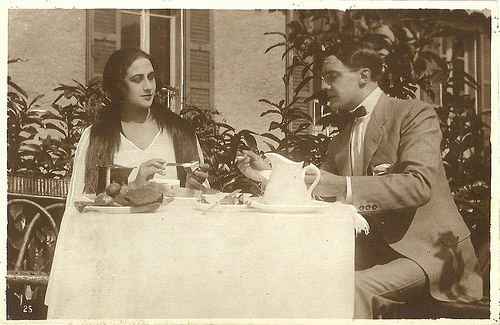
Italian postcard, no. 23. Photo: Società cinematografica FERT. Publicity still for La grande passione (Mario Almirante, 1922), starring Italia Almirante Manzini and André Habay . Caption: Joint life in their retreat.
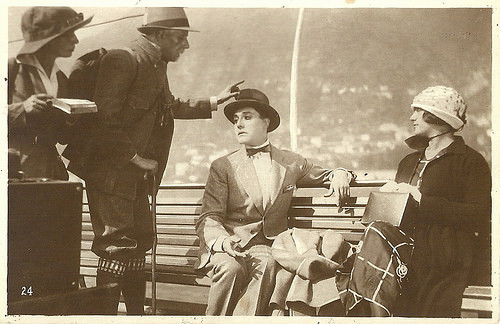
Italian postcard, no. 24. Photo: Società cinematografica FERT. Publicity still for La grande passione (Mario Almirante, 1922), starring Italia Almirante Manzini and André Habay . Caption: A trip on Lake Como.
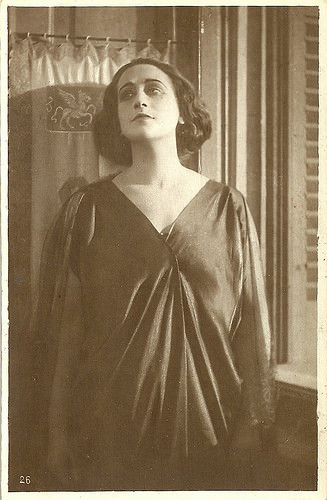
Italian postcard, no. 26. Photo: Società cinematografica FERT. Publicity still for La grande passione (Mario Almirante, 1922), starring Italia Almirante Manzini .

Italian postcard, no. 27. Photo: Società cinematografica FERT. Publicity still for La grande passione (Mario Almirante, 1922). Caption: The presentation of Ottavio. The name is puzzling as there is no character of that name in the film. Probably meant is Marcello. So Maria's husband Carli (Joaquin Carrasco) presents his nephew Marcello (Carlo Benetti) to Maria ( Italia Almirante ).
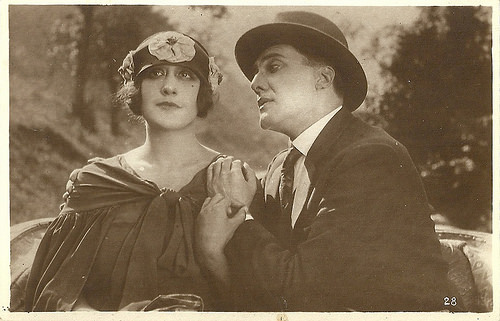
Italian postcard, no. 28. Photo: Società cinematografica FERT. Publicity still for La grande passione (Mario Almirante, 1922), starring Italia Almirante Manzini and André Habay . Caption: You want to to flee with me... forever?
Sources: Sempre in penombra (Italian), Wikipedia (Italian), and IMDb.

Italian postcard, no. 15. Photo: Società cinematografica FERT. Publicity still for La grande passione (Mario Almirante, 1922), starring Italia Almirante Manzini and here with Carlo Benetti. Caption: If you decide to accept we could take the 19:00 train. Think about this when you have calmed down.

Italian postcard, no. 16. Photo: Società cinematografica FERT. Publicity still for La grande passione (Mario Almirante, 1922). Caption: After the duel in American style.

Italian postcard, no. 17. Photo: Società cinematografica FERT. Publicity still for La grande passione (Mario Almirante, 1922), starring Italia Almirante Manzini and Carlo Benetti. Caption: Oh? Dignity?... Which one?

Italian postcard, no. 18. Photo: Società cinematografica FERT. Publicity still for La grande passione (Mario Almirante, 1922). Caption: My dear, I understand you and I love you.

Italian postcard, no. 19. Photo: Società cinematografica FERT. Publicity still for La grande passione (Mario Almirante, 1922). Caption: Patrizio Algesio and Gaspare Lucidi.
Not love but serenity
La grande passione (1922) tells the story of Maria (Italia Almirante Manzini), an orphan, who lives with her uncle (Vittorio Pieri). Her beauty raises the jealousy of her female cousins, who persecute her.
Maria is almost obliged to accept a marriage offer by a rich widower, Carli (Joaquin Carrasco). It is not love but serenity. Love appears as another man, Marcello (Carlo Benetti), cousin of Carli, starts to court Maria. A friend, Patrizio ( André Habay ), warns her in vain.
After being left by Marcello, Maria accepts the sincere and disinterested love of Patrizio. When Marcello returns and wants Maria back, a duel with Patrizio follows in which Marcello is killed. In the meantime Carli has been ruined by Marcello. It is then that Maria understands her plight to stay close to her husband, sacrificing her great love for Patrizio, while returning to Carli.
When La grande passione was released in Italy in early 1923 it was praised by the Italian trade press. Both La vita cinematografica and La rivista cinematografica lauded both Mario Almirante's direction and Italia Almirante 's dramatic performance.

Italian postcard, no. 20. Photo: Società cinematografica FERT. Publicity still for La grande passione (Mario Almirante, 1922), starring Italia Almirante Manzini and André Habay . Caption: You are still decided to never leave me.

Italian postcard, no. 21. Photo: Società cinematografica FERT. Publicity still for La grande passione (Mario Almirante, 1922), starring Italia Almirante Manzini and André Habay . Caption: Caption: The past.

Italian postcard, no. 22. Photo: Società cinematografica FERT. Publicity still for La grande passione (Mario Almirante, 1922), starring Italia Almirante Manzini . Caption: Separation.

Italian postcard, no. 23. Photo: Società cinematografica FERT. Publicity still for La grande passione (Mario Almirante, 1922), starring Italia Almirante Manzini and André Habay . Caption: It's about to leave!

Italian postcard, no. 23. Photo: Società cinematografica FERT. Publicity still for La grande passione (Mario Almirante, 1922), starring Italia Almirante Manzini and André Habay . Caption: Joint life in their retreat.

Italian postcard, no. 24. Photo: Società cinematografica FERT. Publicity still for La grande passione (Mario Almirante, 1922), starring Italia Almirante Manzini and André Habay . Caption: A trip on Lake Como.

Italian postcard, no. 26. Photo: Società cinematografica FERT. Publicity still for La grande passione (Mario Almirante, 1922), starring Italia Almirante Manzini .

Italian postcard, no. 27. Photo: Società cinematografica FERT. Publicity still for La grande passione (Mario Almirante, 1922). Caption: The presentation of Ottavio. The name is puzzling as there is no character of that name in the film. Probably meant is Marcello. So Maria's husband Carli (Joaquin Carrasco) presents his nephew Marcello (Carlo Benetti) to Maria ( Italia Almirante ).

Italian postcard, no. 28. Photo: Società cinematografica FERT. Publicity still for La grande passione (Mario Almirante, 1922), starring Italia Almirante Manzini and André Habay . Caption: You want to to flee with me... forever?
Sources: Sempre in penombra (Italian), Wikipedia (Italian), and IMDb.
Published on March 22, 2017 23:00
March 21, 2017
Vintage cigarette cards
Last year, EFSP had two posts about cigarette cards made by Ross Verlag in Berlin before the war: Bunte Filmbilder (Our Colourful Film Pictures) and Bunte Filmbilder (Colourful Film Pictures). The cards were enclosed in the packs of Josetti's various brands of cigarettes. Today EFSP presents German cigarette cards, made by an unnamed publisher after the war, and British cigarette cards with pin-ups from the 1930s.
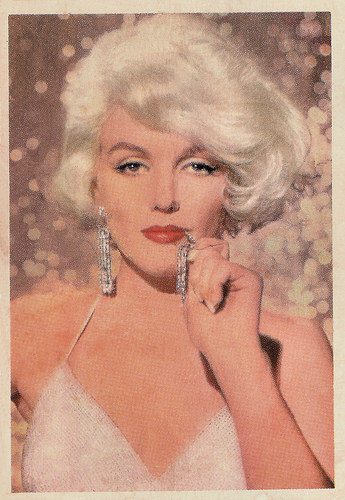
Marilyn Monroe . German cigarette card, no. 30. Photo: 20th Century Fox.
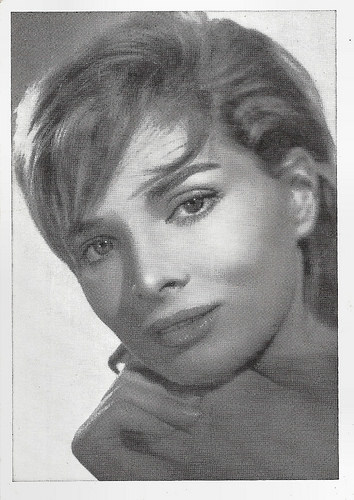
Scilla Gabel . German cigarette card. Photo: Jiano.
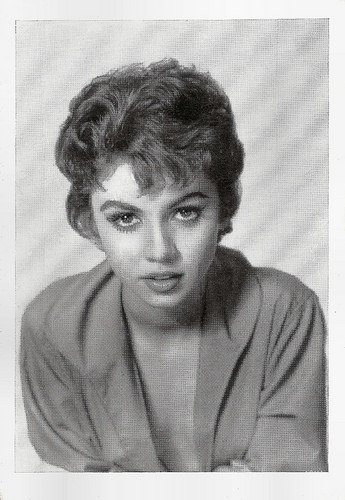
Jackie Lane. German cigarette card.

Giovanna Ralli . German cigarette card.
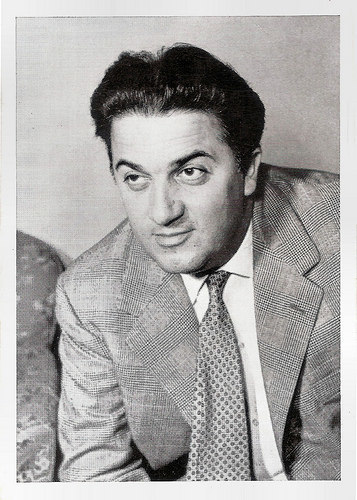
Federico Fellini. German cigarette card.
Italian film director and screenwriter Federico Fellini (1920-1993) was one of the most influential filmmakers of all time. He was known for his distinct style that blends fantasy and baroque images with earthiness. In a career spanning almost fifty years, Fellini won the Palme d'Or for La Dolce Vita, was nominated for twelve Academy Awards, and directed four motion pictures that won Oscars in the category of Best Foreign Language Film.
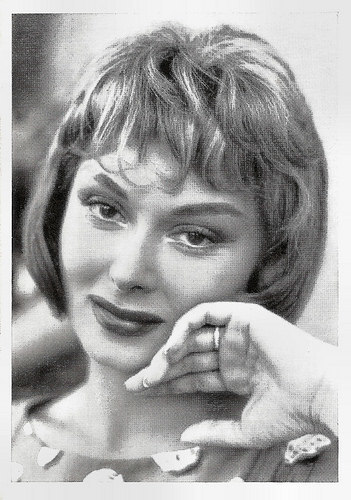
Dorian Gray . German cigarette card. Photo: Frontini.
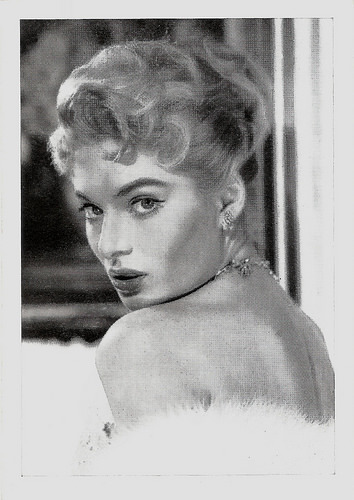
Belinda Lee . German cigarette card. Photo: Treuhaft.
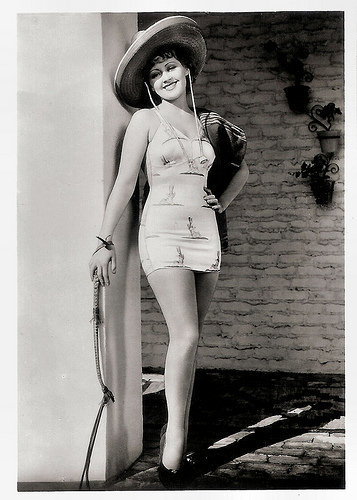
Joan Blondell. British cigarette card by State Express and Ardath Cigarettes, Series two, number 9. Photo: First National.
American actress Joan Blondell (1906–1979) performed in more than 100 movies and on television for five decades, often as the wisecracking blonde.
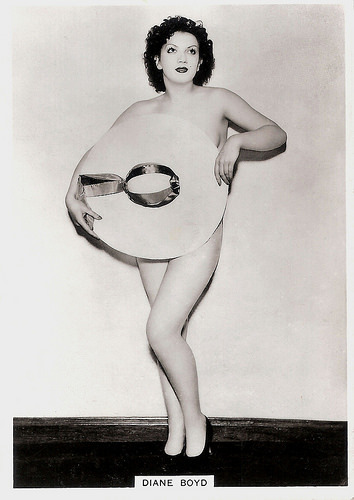
Diane Boyd. British cigarette card in the Seventh series of Modern Beauties, no. 16. Caption: 16 year old lady of chorus at the Prince of Wales's Theatre, London. This is one of a series of 36 real photographs now being packed with these cigarettes.
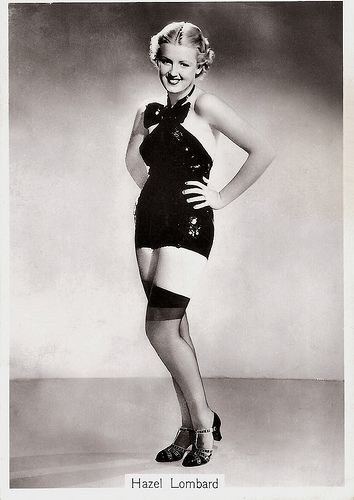
Hazel Lombard. British cigarette card in the Third series of Beauties of To-Day by Godfrey Phillips Ltd, no. 5.
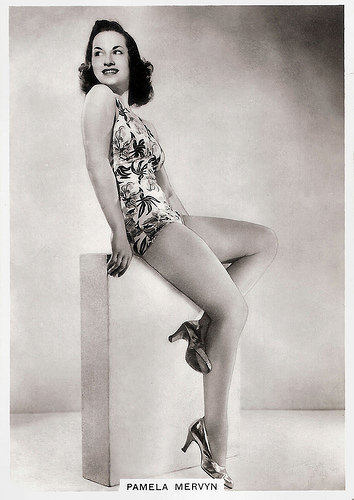
Pamela Mervyn. British cigarette card in the Seventh series of Modern Beauties, no. 6. Caption: Pamela Mervyn of the Windmill Theatre, London.
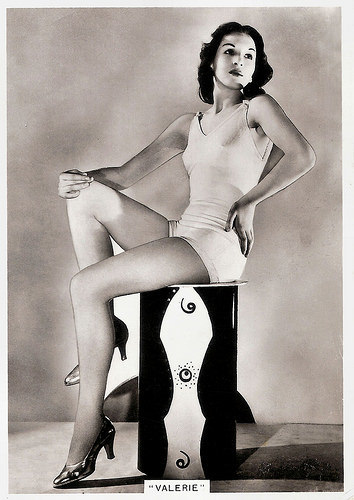
Valerie. British cigarette card in the Seventh series of Modern Beauties, no. 8.

Marilyn Monroe . German cigarette card, no. 30. Photo: 20th Century Fox.

Scilla Gabel . German cigarette card. Photo: Jiano.

Jackie Lane. German cigarette card.

Giovanna Ralli . German cigarette card.

Federico Fellini. German cigarette card.
Italian film director and screenwriter Federico Fellini (1920-1993) was one of the most influential filmmakers of all time. He was known for his distinct style that blends fantasy and baroque images with earthiness. In a career spanning almost fifty years, Fellini won the Palme d'Or for La Dolce Vita, was nominated for twelve Academy Awards, and directed four motion pictures that won Oscars in the category of Best Foreign Language Film.

Dorian Gray . German cigarette card. Photo: Frontini.

Belinda Lee . German cigarette card. Photo: Treuhaft.

Joan Blondell. British cigarette card by State Express and Ardath Cigarettes, Series two, number 9. Photo: First National.
American actress Joan Blondell (1906–1979) performed in more than 100 movies and on television for five decades, often as the wisecracking blonde.

Diane Boyd. British cigarette card in the Seventh series of Modern Beauties, no. 16. Caption: 16 year old lady of chorus at the Prince of Wales's Theatre, London. This is one of a series of 36 real photographs now being packed with these cigarettes.

Hazel Lombard. British cigarette card in the Third series of Beauties of To-Day by Godfrey Phillips Ltd, no. 5.

Pamela Mervyn. British cigarette card in the Seventh series of Modern Beauties, no. 6. Caption: Pamela Mervyn of the Windmill Theatre, London.

Valerie. British cigarette card in the Seventh series of Modern Beauties, no. 8.
Published on March 21, 2017 23:00
March 20, 2017
Dagny Servaes
Dagny Servaes (1894-1961) was a German-Austrian theatre and film actress. She made her first film appearance in 1916 and reached her peak in Ernst Lubitsch' Das Weib des Pharao/The Pharaoh's Wife (1921).
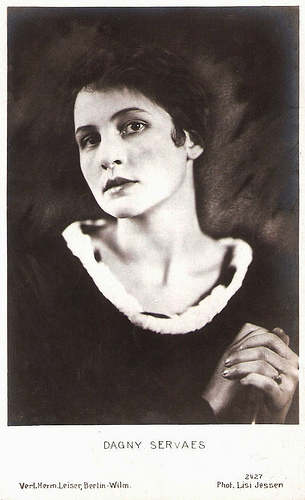
German postcard by Verl. Herm. Leiser, Berlin-Wilm., no. 2427. Photo: Lisi Jessen.
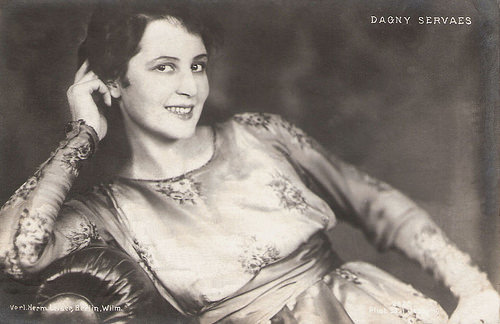
German postcard by Verl. Herm. Leiser, Berlin-Wilm., no. 2429. Photo: Lisi Jessen. Sent by mail in 1918.
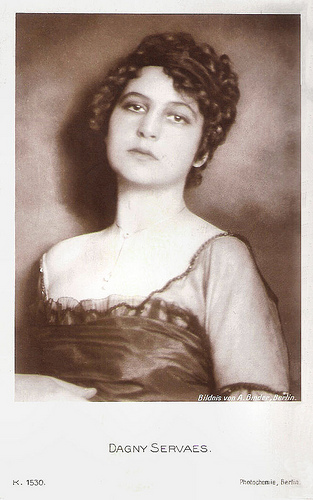
German postcard by Photochemie, Berlin. K. 1530. Photo Alex Binder, Berlin.
War Propaganda
Dagny Servaes was born in Berlin in 1894. She was the daughter of author Franz Servaes.
Dagny took acting lessons at the Wiener Akademie für Musik und Darstellende Kunst (Viennese academy for music and performing arts). In 1912 she managed to have an engagement at the Hoftheater in Meiningen, and from 1913 on Servaes played at the reputed Berliner Bühnen as well as at the Deutschen Theater, Lessingtheater and Staatstheater.
From 1916 on, Dagny Servaes played in silent cinema as well, where she soon became a leading actress. Her debut was in the war propaganda film Das Tagebuch des Dr. Hart (1916) by Paul Leni.
That same year she appeared opposite Emil Jannings in Stein unter Steinen/Stone under stones (Felix Basch, 1916).
In the late 1910s she did several films with director Emmerich Hanus, including Aranka und Arauka/Aranka and Arauka (Emmerich Hanus, 1918), Das Geheimnis des Irren/The secret of wandering (Emmerich Hanus, 1919) and Die Nacht der Prüfung/The night of the test (Emmerich Hanus, 1920) with Theodor Loos .
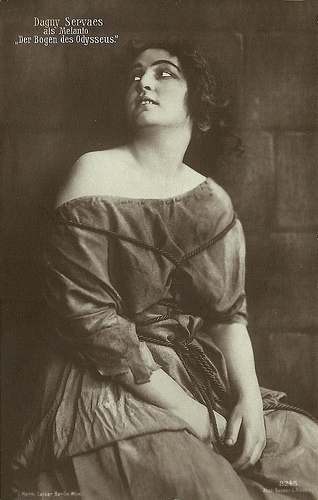
German postcard by Hermann Leiser, Berlin, no. 8245. Photo: Becker & Maass. Publicity still for Der Bogen des Odysseus. Collection: Didier Hanson.

German postcard by Photochemie, Berlin, no. K. 2001. Photo: Union Film. Publicity still for John Riew (Walter Schmidthässler, 1917) with Karl Valentin, Dagny Servaes and Käthe Dorsch .
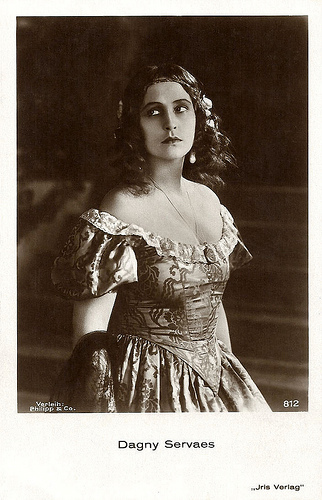
Austrian postcard by Iris Verlag, no. 812. Photo: Verleih Philipp & Co.
Lubitsch
Dagny Servaes reached her peak in 1921 with the female lead as a beautiful slave girl in Ernst Lubitsch ‘ historical epic Das Weib des Pharao/The Pharaoh’s Wife (Ernst Lubitsch, 1921). The film also starred Emil Jannings as the Pharaoh who falls in love with the slave girl, and Harry Liedtke as Ramphis, her real love interest.
Thomas Staedeli writes at Cyranos : "In 1922 she appeared in Das Weib des Pharao, one of the biggest productions of the year and they predicted her a great career like Pola Negri . But oddly enough her film career got stuck at the beginning, she never played again such an important part as in Das Weib des Pharao."
A memorable lead was the Russian spy Sonia in Oberst Redl/Colonel Redl (Hans Otto Löwenstein, 1924). Sixty years later, Redl’s life was again filmed by Istvan Szabo.
Even though she was celebrated as a star, Servaes’ parts became a bit smaller in the following years, as in Die lachende Grille/The Laughing Cricket (Friedrich Zelnik, 1926) starring Lya Mara , and Die Weber/The Weaver (Friedrich Zelnik, 1927) starring Paul Wegener .
In 1926 she temporarily left the screen and returned to the stage. She joined Max Reinhardt‘s ensemble for a theatre tour across the United States in 1926-1928. In New York she performed in Jedermann/Everyman, Ein Sommernachtstraum/Midsummer Night’s Dream, Dantons Tod/Danton’s Death and Carlo Goldoni‘s Diener zweier Herren/Servant of Two Masters.
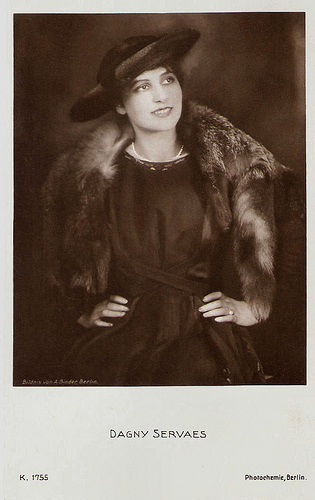
German postcard by Photochemie, Berlin, no. K 1755. Photo: Alex Binder, Berlin.
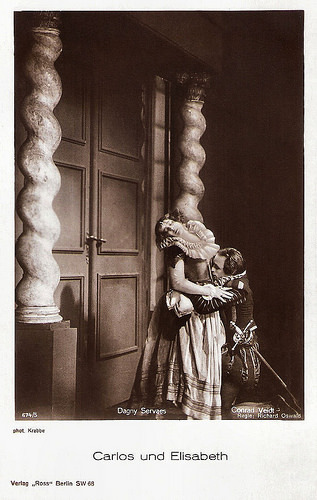
German postcard by Ross Verlag, Berlin, no. 674/5. Photo: Krabbe. Publicity still for Carlos und Elisabeth/Carlos and Elisabeth (Richard Oswald, 1924) with Conrad Veidt.
Der Jozefstadt
In 1936 Dagny Servaes established herself in Vienna and played secondary parts in sound films. From 1938 to 1948 she played at the Theater in der Josefstadt and from 1950 on mostly at the Volkstheater. From 1952 on she was part of the ensemble of the Burgtheater.
Until 1959 Servaes played in dozens of German and Austrian films. Among her German films were the UFA comedy Die Töchter ihrer Excellenz/The daughters of Her Excellency (Reinhold Schünzel, 1934) with Käthe von Nagy , Nanon (Herbert Maisch, 1938) with Johannes Heesters , Friedrich Schiller (Herbert Maisch, 1940), and the tearjerker Die goldene Stadt/The Golden City (Veit Harlan, 1942) starring Kristina Söderbaum .
Her Austrian films included Unsterbliche Walzer/Immortal Waltz (E.W. Emo, 1939) as the wife of Johan Strauss Sr. ( Paul Hörbiger ), Eroica (Walter Kolm-Veltée, 1949) - a biopic on Ludwig von Beethoven (Ewald Balser) - and the Heimat-film Die Regimentstochter/Daughter of the Regiment (George C. Klaren, 1953).
Her last feature film was the romantic drama Der Schandfleck/The disgrace (Herbert B. Fredersdorf, 1956) with Gerlinde Locker .
Dagny Servaes died in Vienna in 1961, her tomb is at the Grinzinger Friedhof. She was married to Erwin Goldarbeiter, an assistant to Max Reinhardt in the 1920s.
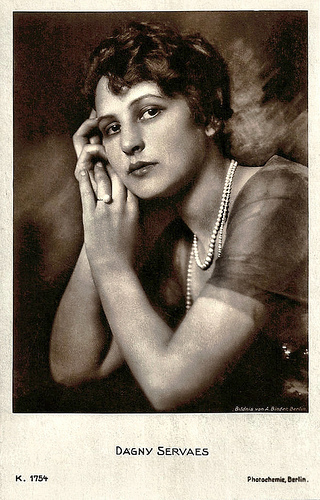
German postcard by Photochemie, Berlin, no. K 1754. Photo: Alex Binder, Berlin.
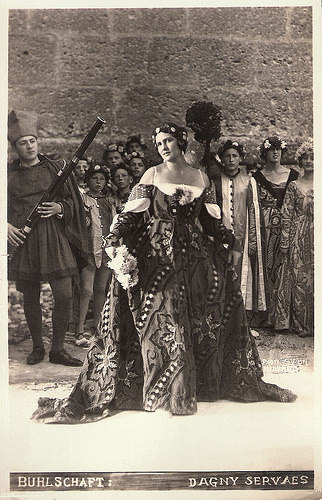
Austrian postcard by Hintner und Traub, Salzburg. Photo: publicity still for the stage play Jedermann (Everyman) by Hugo von Hofmannsthal at the Salzburger Festspiele. She played the part of Buhlschaft from 1926 till 1937.
Sources: Thomas Staedeli (Cyranos), Filmportal.de, Wikipedia (German) and . Thanks to Helmut Books for the corrections.

German postcard by Verl. Herm. Leiser, Berlin-Wilm., no. 2427. Photo: Lisi Jessen.

German postcard by Verl. Herm. Leiser, Berlin-Wilm., no. 2429. Photo: Lisi Jessen. Sent by mail in 1918.

German postcard by Photochemie, Berlin. K. 1530. Photo Alex Binder, Berlin.
War Propaganda
Dagny Servaes was born in Berlin in 1894. She was the daughter of author Franz Servaes.
Dagny took acting lessons at the Wiener Akademie für Musik und Darstellende Kunst (Viennese academy for music and performing arts). In 1912 she managed to have an engagement at the Hoftheater in Meiningen, and from 1913 on Servaes played at the reputed Berliner Bühnen as well as at the Deutschen Theater, Lessingtheater and Staatstheater.
From 1916 on, Dagny Servaes played in silent cinema as well, where she soon became a leading actress. Her debut was in the war propaganda film Das Tagebuch des Dr. Hart (1916) by Paul Leni.
That same year she appeared opposite Emil Jannings in Stein unter Steinen/Stone under stones (Felix Basch, 1916).
In the late 1910s she did several films with director Emmerich Hanus, including Aranka und Arauka/Aranka and Arauka (Emmerich Hanus, 1918), Das Geheimnis des Irren/The secret of wandering (Emmerich Hanus, 1919) and Die Nacht der Prüfung/The night of the test (Emmerich Hanus, 1920) with Theodor Loos .

German postcard by Hermann Leiser, Berlin, no. 8245. Photo: Becker & Maass. Publicity still for Der Bogen des Odysseus. Collection: Didier Hanson.

German postcard by Photochemie, Berlin, no. K. 2001. Photo: Union Film. Publicity still for John Riew (Walter Schmidthässler, 1917) with Karl Valentin, Dagny Servaes and Käthe Dorsch .

Austrian postcard by Iris Verlag, no. 812. Photo: Verleih Philipp & Co.
Lubitsch
Dagny Servaes reached her peak in 1921 with the female lead as a beautiful slave girl in Ernst Lubitsch ‘ historical epic Das Weib des Pharao/The Pharaoh’s Wife (Ernst Lubitsch, 1921). The film also starred Emil Jannings as the Pharaoh who falls in love with the slave girl, and Harry Liedtke as Ramphis, her real love interest.
Thomas Staedeli writes at Cyranos : "In 1922 she appeared in Das Weib des Pharao, one of the biggest productions of the year and they predicted her a great career like Pola Negri . But oddly enough her film career got stuck at the beginning, she never played again such an important part as in Das Weib des Pharao."
A memorable lead was the Russian spy Sonia in Oberst Redl/Colonel Redl (Hans Otto Löwenstein, 1924). Sixty years later, Redl’s life was again filmed by Istvan Szabo.
Even though she was celebrated as a star, Servaes’ parts became a bit smaller in the following years, as in Die lachende Grille/The Laughing Cricket (Friedrich Zelnik, 1926) starring Lya Mara , and Die Weber/The Weaver (Friedrich Zelnik, 1927) starring Paul Wegener .
In 1926 she temporarily left the screen and returned to the stage. She joined Max Reinhardt‘s ensemble for a theatre tour across the United States in 1926-1928. In New York she performed in Jedermann/Everyman, Ein Sommernachtstraum/Midsummer Night’s Dream, Dantons Tod/Danton’s Death and Carlo Goldoni‘s Diener zweier Herren/Servant of Two Masters.

German postcard by Photochemie, Berlin, no. K 1755. Photo: Alex Binder, Berlin.

German postcard by Ross Verlag, Berlin, no. 674/5. Photo: Krabbe. Publicity still for Carlos und Elisabeth/Carlos and Elisabeth (Richard Oswald, 1924) with Conrad Veidt.
Der Jozefstadt
In 1936 Dagny Servaes established herself in Vienna and played secondary parts in sound films. From 1938 to 1948 she played at the Theater in der Josefstadt and from 1950 on mostly at the Volkstheater. From 1952 on she was part of the ensemble of the Burgtheater.
Until 1959 Servaes played in dozens of German and Austrian films. Among her German films were the UFA comedy Die Töchter ihrer Excellenz/The daughters of Her Excellency (Reinhold Schünzel, 1934) with Käthe von Nagy , Nanon (Herbert Maisch, 1938) with Johannes Heesters , Friedrich Schiller (Herbert Maisch, 1940), and the tearjerker Die goldene Stadt/The Golden City (Veit Harlan, 1942) starring Kristina Söderbaum .
Her Austrian films included Unsterbliche Walzer/Immortal Waltz (E.W. Emo, 1939) as the wife of Johan Strauss Sr. ( Paul Hörbiger ), Eroica (Walter Kolm-Veltée, 1949) - a biopic on Ludwig von Beethoven (Ewald Balser) - and the Heimat-film Die Regimentstochter/Daughter of the Regiment (George C. Klaren, 1953).
Her last feature film was the romantic drama Der Schandfleck/The disgrace (Herbert B. Fredersdorf, 1956) with Gerlinde Locker .
Dagny Servaes died in Vienna in 1961, her tomb is at the Grinzinger Friedhof. She was married to Erwin Goldarbeiter, an assistant to Max Reinhardt in the 1920s.

German postcard by Photochemie, Berlin, no. K 1754. Photo: Alex Binder, Berlin.

Austrian postcard by Hintner und Traub, Salzburg. Photo: publicity still for the stage play Jedermann (Everyman) by Hugo von Hofmannsthal at the Salzburger Festspiele. She played the part of Buhlschaft from 1926 till 1937.
Sources: Thomas Staedeli (Cyranos), Filmportal.de, Wikipedia (German) and . Thanks to Helmut Books for the corrections.
Published on March 20, 2017 23:00
March 19, 2017
Richard Burton
Richard Burton (1927–1984) was one of the great British actors of the post World War II period. Although never trained as an actor, he became famous on stage in most of the plays by William Shakespeare. Blessed with a thrillingly theatrical voice, Burton also became, at one time, the highest-paid film actor in the world. He was nominated seven times for an Academy Award, six of which were for Best Actor in a Leading Role (without ever winning), and he was a recipient of BAFTA, Golden Globe and Tony Awards for Best Actor. His adulterous romance with Elizabeth Taylor became an international scandal and their two tempestuous marriages were covered in detail by the Paparazzi.
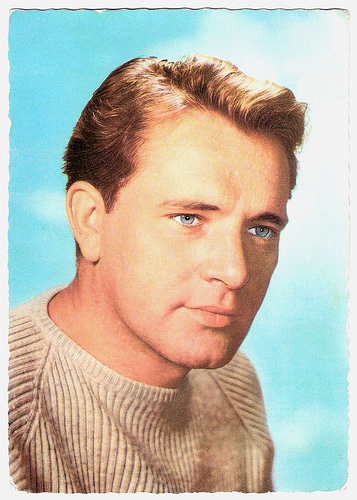
French postcard by ISV / Huit, no. B 9. Photo: 20th Century Fox. Publicity still for Sea Wife (Bob McNaught, 1957).
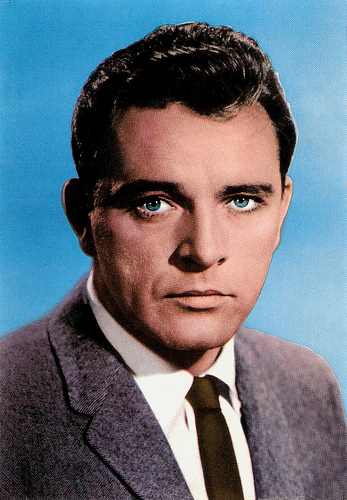
Spanish postcard by Postalcolor, Barcelona, no. 35, 1963.

Spanish postcard by Postal Oscarcolor, no. 118.
An impoverished Welsh living
Richard Burton was born Richard Walter Jenkins in the village of Pontrhydyfen, Wales in 1925. He was the twelfth of thirteen children. His father, Richard Walter Jenkins, was a short, robust coal miner, a ‘twelve-pints-a-day man’.
Burton was less than two years old in 1927 when his mother, Edith Maude (née Thomas), died at the age of 43 after giving birth to her 13th child. His sister Cecilia ‘Cis’ and her husband Elfed took him into their Presbyterian mining family in nearby Port Talbot (an English-speaking steel town). He grew up speaking Cymraeg (Welsh) as well as English. His 19 year older brother Ifor became his de facto father figure, and in later years, his assistant and boon companion.
Burton showed a talent for English and Welsh literature at grammar school, and demonstrated an excellent memory, though his consuming interest was sports – rugby. He earned pocket money by running messages, hauling horse manure, and delivering newspapers. He started to smoke at the age of eight and to drink regularly at twelve. He believed that the way out of an impoverished Welsh living was to read, and he was always reading books.
Inspired by his schoolmaster, Philip H. Burton, he excelled in school productions, his first being The Apple Cart. The young man had spoken no English until the age of ten. Burton taught him to speak English without a Welsh accent, to read the classics, and to hold a knife and fork. Richard left school at sixteen for full-time work. He worked for the local wartime co-operative committee, handing out supplies in exchange for coupons, but then considered other professions for his future, including boxing, religion and singing.
When Jenkins joined the Port Talbot Squadron of the Air Training Corps as a cadet, he re-encountered Philip Burton, his former teacher, who was the commander. Burton rigorously schooled him in both literature and acting, even sending him to Welsh mountaintops to work on voice projection. After receiving his school certificate, Richard was accepted to Exeter College at Oxford for a special term of study. In order to gain admittance as an undergraduate, Philip Burton was required to adopt the young man; after discovering that it was legally impossible to do so, he made Richard his ward, and changed his surname to Burton.
Before leaving for Exeter, Burton made his professional acting debut in the play The Druid's Rest in 1944. The show was successful enough to move to London, where he received his first positive review in the New Statesman magazine. Those words would solidify Burton's resolve to become an actor.
While at Exeter, he appeared in his first significant Shakespearean role - Angelo in Measure for Measure - before an audience that included such important theatrical figures as John Gielgud and Terence Rattigan. Subsequently he served in the RAF (1944–1947) as a navigator. In 1947, after his discharge, Burton went to London to seek his fortune. He immediately signed up with a theatrical agency to make himself available for casting calls. His first film was The Last Days of Dolwyn (Russell Lloyd, Emlyn Williams, 1949), set in a Welsh village about to be drowned to provide a reservoir.
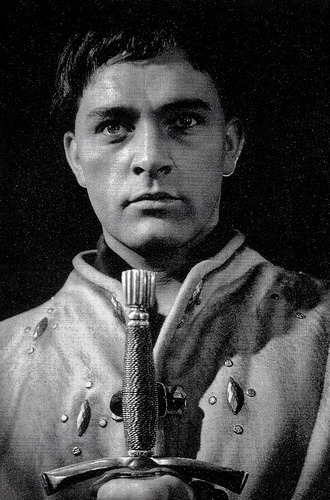
British postcard in the Shakespeare Memorial Theatre series, no. 18. Photo: Angus McBean. Richard Burton as Prince Hal in the stage production of Henry IV, Part I and Henry IV, Part 2, Stratford-upon-Avon, 1951.
He met his future wife, the young actress Sybil Williams, on the set, and they married in 1949. They had two daughters, and divorced in 1963 after Burton's widely reported affair with Elizabeth Taylor . In the years of his marriage to Sybil, Burton appeared in the West End in a highly successful production of The Lady's Not for Burning, alongside Sir John Gielgud and Claire Bloom , in both the London and New York productions.
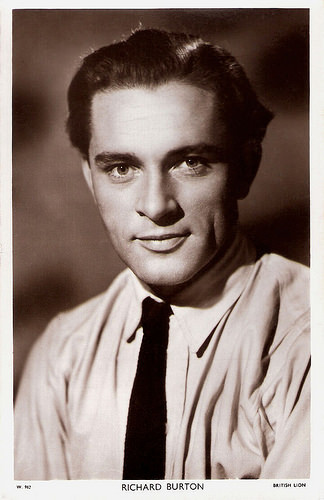
British postcard in the Picturegoer series, London, no. W 912. Photo: British Lion.
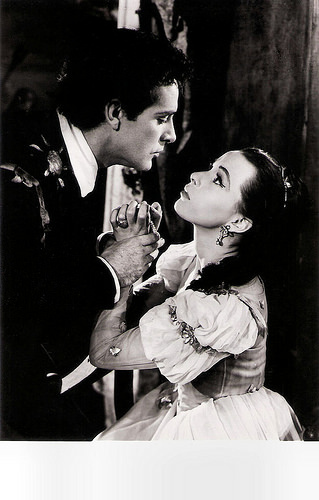
Danish postcard by Kaj Brammers Boghandel, Helsingor, no. 748. Photo: publicity still for the stage production of Hamlet at the Hamletspillene in Kronborg, 1954. Richard Burton as Hamlet and Claire Bloom as Ophelia.
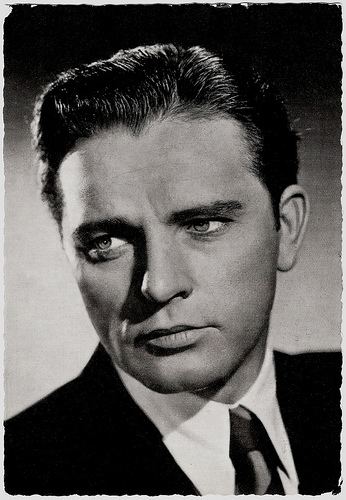
German postcard by WS-Druck, Wanne-Eickel, no 226. Offered by Macaroni Honig, Gent (Belgium). Photo: Centfox.
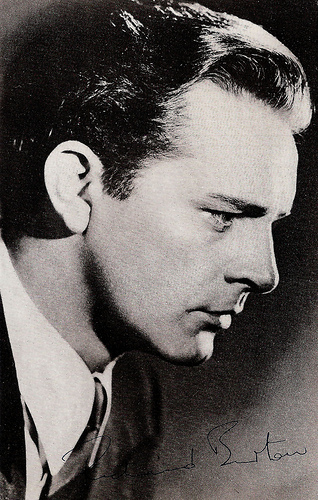
British postcard in the Film Star Autograph Portrait series by Celebrity Publishers, London, no. 79.
A Watchful Brooding Intensity
Richard Burton had small parts in various low-key British films: Now Barabbas (Gordon Parry, 1950) starring Richard Greene , Waterfront (Michael Anderson, 1950) with Robert Newton, The Woman with No Name (Ladislao Vajda, 1951) featuring Phyllis Calvert , and a bigger part as a smuggler in the B-film Green Grow the Rushes (Derek N. Twist, 1951). He displayed a watchful brooding intensity in these films.
In the 1951 season at Stratford, he gave a critically acclaimed performance and achieved stardom as Prince Hal in Shakespeare's Henry IV, Part 1 opposite Anthony Quayle's Falstaff. Burton was already demonstrating the same independence and competitiveness as an actor that he displayed off-stage in drinking, sport, or story-telling. He was admitted to the post-War British acting circle which included Anthony Quayle, John Gielgud , Michael Redgrave , Hugh Griffith and Paul Scofield.
The following year, Burton signed a five-year contract with Alexander Korda at £100 a week, launching his Hollywood career. On the recommendation of Daphne du Maurier, he was given the leading role in the mystery-romance My Cousin Rachel (Henry Koster, 1952) opposite Olivia de Havilland. Burton arrived on the Hollywood scene at a time when the studios were struggling. Television's rise was drawing away viewers and the studios looked to new stars and new film technology to staunch the bleeding. 20th Century Fox negotiated with Korda to borrow him for this film and a further two at $50,000 a film. My Cousin Rachel was a critical success. It established Burton as a Hollywood leading man and won him his first Academy Award nomination and the Golden Globe Award for New Star of the Year – Actor.
In the wartime action-drama The Desert Rats (Robert Wise, 1953), Burton plays a young English captain in the North African campaign during World War II who takes charge of a hopelessly out-numbered Australian unit against the indomitable Field Marshal Erwin Rommel ( James Mason ). Then he created a sensation by starring in the biblical epic The Robe (Henry Koster, 1953), the first film to premiere in the wide-screen process CinemaScope. The film was a colossal hit, it gave Burton his second Oscar nomination, and minted him as a genuine movie star.
Burton was offered a seven-year, $1 million contract by Darryl F. Zanuck at Fox, but he turned it down, though later the contract was revived and he agreed to it. Between 1953 and 1956, he was juggling theatre with film, playing Hamlet and Coriolanus at the Old Vic theatre and alternating the roles of Iago and Othello with the Old Vic's other rising matinee idol John Neville. For his Henry V he won the Evening Standard drama award.
Known for his resonant voice he also gave frequent readings of classic works on BBC Radio. In 1954, Burton took his most famous radio role, as the narrator in the original production of Dylan Thomas' Under Milk Wood, a role he would reprise in the film version twenty years later.
Burton appeared on Broadway, receiving a Tony Award nomination for Time Remembered (1958) and winning the award for playing King Arthur in the musical Camelot (1960). The latter show went on to run for over 800 performances, and netted a total of four Tony Awards. He then put his stage career on the back burner to concentrate on film.
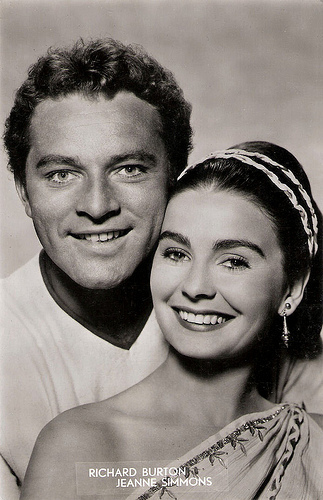
French postcard. Photo: publicity still for The Robe (1953) with Jean Simmons .

German postcard by Kolibri-Verlag G.m.b.H., Minden/Westf., no. 2395. Photo: United Artists. Publicity still for Alexander the Great (1956).
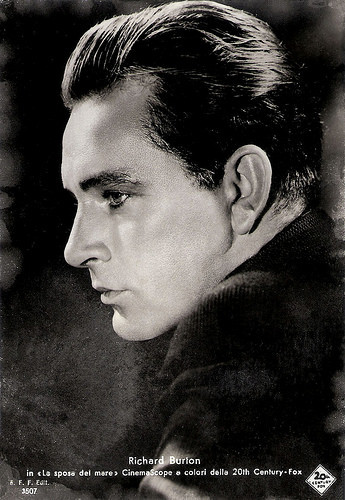
Italian postcard by B.F.F. Edit. (Ballerini & Fratini, Firenze), no. 2507. Photo: 20th Century Fox. Publicity still for Sea Wife (Bob McNaught, 1957).

West-German postcard by Ufa, Berlin-Tempelhof, no. FK 4738. Photo: Terb-Agency.

West-German postcard by Rüdel Verlag, Hamburg-Bergedorf, no 1453. Photo: 20th Century Fox.
Liz and Dick
In terms of critical success, Richard Burton's Hollywood roles throughout the 1950s did not live up to the early promise of his debut. Burton returned to Hollywood to star in The Prince of Players (Philp Dunne, 1955), another historical CinemaScope film, this time concerning Edwin Booth, famous American actor and brother of Abraham Lincoln's assassin John Wilkes Booth.
Next came Alexander The Great (Robert Rossen, 1956), with the handsome and self-assured Burton in the title role, on a loan out to United Artists, and again with Claire Bloom co-starring. Contrary to Burton's expectations, the ‘intelligent epic’ was a wooden, slow-paced flop.
In The Rains of Ranchipur (Jean Negulesco, 1955) Burton plays a noble Hindu doctor who attempts the spiritual recovery of an adulteress (Lana Turner). In Sea Wife (Bob McNaught, 1957), shot in Jamaica, a young Joan Collins plays a nun shipwrecked on an island with three men.
For the British cinema the late 1950s was an exciting and inventive time, often referred to as the British New Wave, and Burton was right in the thick of things. In 1958, he was offered the part of Jimmy Porter, ‘an angry young man’ role, in the film version of John Osborne's play Look Back in Anger (Tony Richardson, 1959).
Hal Erickson writes at AllMovie : “His own film greatness would not manifest itself until he played the dirt-under-the-nails role of Jimmy Porter in Look Back in Anger (1959). In this, he spoke the vernacular of regular human beings - rather than that of high-priced, affected Hollywood screenwriters - and delivered a jolting performance as a working-class man trapped by the system and his own personal demons.” Although it didn't do well commercially, Burton was proud of the effort.
After playing King Arthur in Camelot on Broadway for six months, Burton was one of the ‘42 international stars’ that appeared in the massive World War II epic The Longest Day (Ken Annakin, Andrew Marton, Bernhard Wicki, 1962).
And then he replaced Stephen Boyd as Mark Antony in the troubled production Cleopatra (Joseph L. Mankiewicz, 1963). Twentieth Century Fox's future appeared to hinge on what became the most expensive movie ever made up until then. During the filming, Burton met and fell in love with Elizabeth Taylor , who was married to Eddie Fisher. Such was the scandal surrounding the Burton-Taylor romance that the U.S. State Department was requested to revoke Burton's visa on grounds that he was ‘detrimental to the morals of the youth of our nation.’
The tidal wave of press about the very public affair only helped to bring the curious public to theatres, which made it the highest grossing film of the year - though still a financial disaster, since its $26 million in ticket sales could never cover its price tag (an estimated $40 million). Cleopatra proved to be the start of Burton's most successful period in Hollywood; he would remain among the top 10 box-office earners for the next four years.
He and Taylor would not be free to marry until 1964 when their respective divorces were complete. Their marriage was the start of a series of on-screen collaborations. In the first, The V.I.P.s (Anthony Asquith, 1964), Burton played a husband who tries to prevent his wife (Taylor) from leaving to join her lover ( Louis Jourdan ) in the VIP lounge of London Airport. It proved to be a box-office hit.
Liz and Dick, as they were known, lived on a grand scale. He bought her jewels, including a 69-carat Cartier diamond. They bought a yacht for $500,000. Then he portrayed the archbishop martyred by Henry II in the title role of Becket (Peter Glenville, 1964), turning in an effective, restrained performance, contrasting with Peter O'Toole 's manic portrayal of Henry.
Burton triumphed as defrocked Episcopal priest Dr. T. Lawrence Shannon in Tennessee Williams' The Night of the Iguana (John Huston, 1964), a film which became another critical and box office success. Part of Burton's success in this film was due to how well he varied his acting with the three female characters, each of whom he tries to seduce differently: Ava Gardner (the randy hotel owner), Sue Lyon (the nubile American tourist), and Deborah Kerr (the poor, repressed artist).
He received a third Tony Award nomination when he reprised his Hamlet under John Gielgud's direction in 1964 in a production that holds the record for the longest run of the play in Broadway history (136 performances).
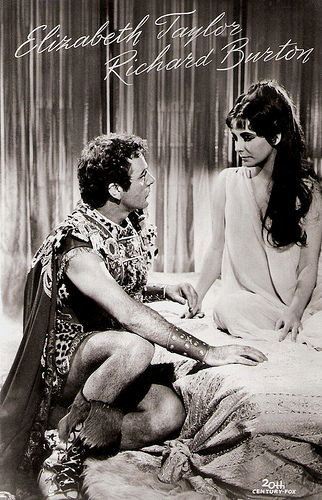
German postcard by Filmbilder-Vertrieb Ernst Freihoff, Essen, no. AX 5536. Photo: publicity still for Cleopatra (Joseph L. Mankiewicz, 1963) with Elizabeth Taylor .
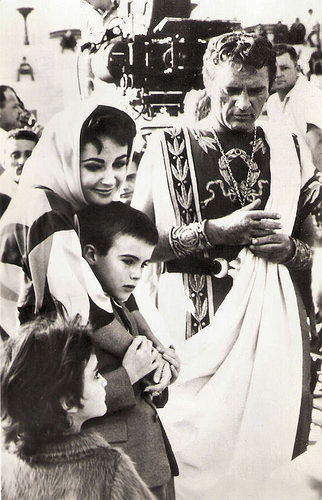
Czech collectors card by Pressfoto, Praha (Prague), no. S 229/2 769. Set photo of Cleopatra (Joseph L. Mankiewicz, 1963) with Elizabeth Taylor and her children.
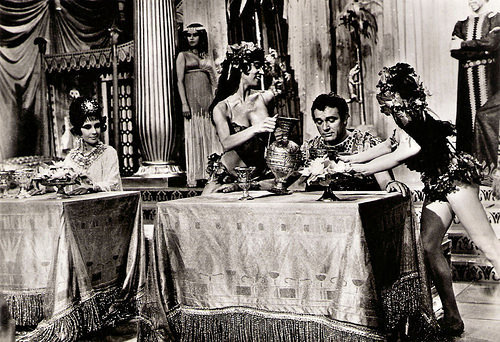
Czech postcard by UPTF Pressfoto, Praha (Prague), no. S 206/7. Photo: publicity still for Cleopatra (Joseph L. Mankiewicz, 1963) with Elizabeth Taylor .
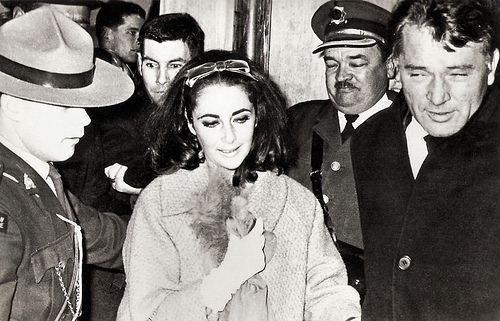
Czech collectors card by Pressfoto, Praha (Prague), no. S 229/6 769, with Elizabeth Taylor .
Lush and rollicking
Richard Burton returned to the cinema as British spy Alec Leamas in The Spy Who Came in from the Cold (Martin Ritt, 1965). Burton and Taylor continued making films together though the next one, The Sandpiper (Vincente Minnelli, 1965), was poorly received.
Following that, he and Elizabeth Taylor were a great success in the film adaptation of the Edward Albee play Who's Afraid of Virginia Woolf? (Mike Nichols, 1966), in which a bitter erudite couple spend the evening trading vicious barbs in front of their horrified and fascinated guests, played by George Segal and Sandy Dennis. Burton was not the first choice for the role of Taylor's husband. Jack Lemmon was offered the role first, but when he backed off, Jack Warner, with Taylor's insistence, agreed on Burton and paid him his price. Although all four actors received Oscar nominations for their roles in the film (the film received a total of thirteen), only Taylor and Dennis went on to win.
Their lush and rollicking adaptation of Shakespeare's The Taming of the Shrew (Franco Zeffirelli, 1967), was a notable success. Later collaborations, however, The Comedians (Peter Glenville, 1967), Boom! (Joseph Losey, 1968), and the Burton-directed Doctor Faustus (Richard Burton, Nevill Coghill, 1967) (which had its genesis from a theatre production he staged and starred in at the Oxford University Dramatic Society) were critical and commercial failures.
He did enjoy a final commercial blockbuster with Clint Eastwood in Where Eagles Dare (Brian G. Hutton, 1968) but his last film of the decade, Anne of the Thousand Days (Charles Jarrott, 1969), was a commercial and critical disappointment. In spite of those failures, it performed remarkably well at that year's Academy awards (receiving ten nominations, including one for Burton's performance as Henry VIII), which many thought to be largely the result of an expensive advertising campaign by Universal Studios.
He was awarded the CBE (Commander of the Order of the British Empire) in the 1970 Queen's Birthday Honours List for his services to drama. He collected this award on his 45th birthday with his older sister Cis, who raised him as a child, and his wife Elizabeth Taylor . Due to Burton and Taylor's extravagant spending and his support of his family and others (42 people at one point), Burton agreed to work in mediocre films such as Bluebeard (Edward Dmytryk, Luciano Sacripanti, 1972) opposite Virna Lisi , Hammersmith Is Out (Peter Ustinov, 1972), and The Klansman (Terence Young, 1974) that hurt his career.
He recognised his financial need to do so, and that in the New Hollywood era of cinema he or Taylor would not soon again be paid as well as at the height of their stardom. The 1972 death of his brother Ifor cast him into a deep depression that brought his marriage to Taylor - once the gold standard for Hollywood unions - to an end in 1974.
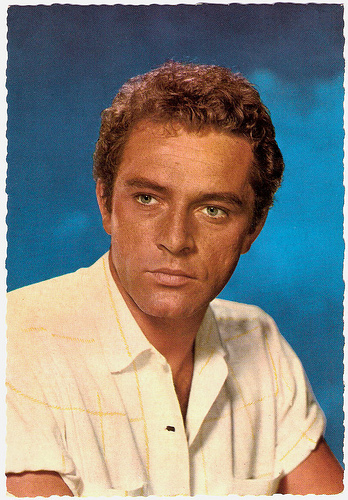
French postcard by E.D.U.G., no. 254.
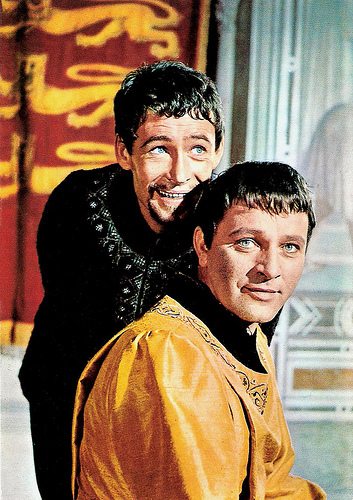
Spanish postcard by Postal Oscarcolor, no. 279. Photo: Publicity shot for Becket (Peter Glenville, 1964) with Peter O'Toole .
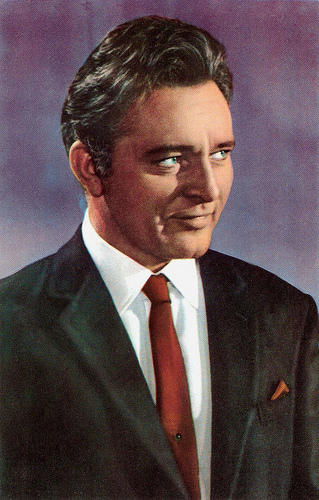
Israelian postcard by Editions de Luxe, no. 10.
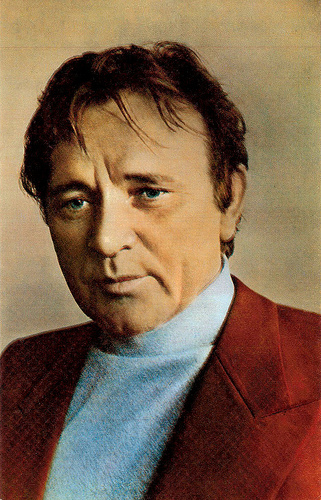
Russian postcard by Izdanije Byuro Propogandy Sovietskogo Kinoiskusstva, 1975. (This postcard was printed in an edition of 200.000 cards.)
Critically Reviled Films
After twelve years, Richard Burton returned to the stage in 1976 in Equus. He replaced Anthony Perkins as psychiatrist Martin Dysart dealing with a young, sexually troubled patient. He won a special Tony Award for his appearance, although he had to make Exorcist II: The Heretic (John Boorman, 1977) before Hollywood producers would allow him to repeat his role in the film version, Equus (Sidney Lumet, 1977). For this role he won the Golden Globe Award as well as an Academy Award nomination. Public sentiment towards his perennial frustration at not winning an Oscar made many pundits consider him the favourite to finally win the award, but on Oscar Night he lost to Richard Dreyfuss in The Goodbye Girl.
In 1976 Burton received a Grammy in the category of Best Recording for Children for his narration of The Little Prince by Antoine de Saint-Exupéry. He also found success in 1978, when he narrated Jeff Wayne's Musical Version of The War of the Worlds. His distinctive performance became a necessary part of the concept album – so much so that a hologram of Burton is used to narrate the live stage show (touring in 2006, 2007, 2009 and 2010) of the musical.
Burton had an international box office hit with The Wild Geese (Andrew V. McLaglen, 1978), an adventure tale co-starring Roger Moore , Richard Harris and Stewart Granger as mercenaries in Africa. He returned to appearing in critically reviled films like The Medusa Touch (Jack Gold, 1978) opposite Lino Ventura , Circle of Two (Jules Dassin, 1980), and opposite Laurence Olivier as Wagner (Tony Palmer, 1983), a role he said he was born to play, after his success in Equus.
He died shortly after the filming of Michael Radford's adaptation of George Orwell's Nineteen Eighty-Four (1984) was completed. Burton played O'Brien, a sinister member of a totalitarian government who tortured John Hurt's low-ranking office worker for the crime of free thought. He was in terrible health during filming from years of alcoholism and heavy smoking, and had to wear a neck brace during rehearsals. His performance as O'Brien in the film was one of his most critically acclaimed performances, and as well as one of his most underplayed.
Richard Burton was nominated six times for an Academy Award for Best Actor and once for an Academy Award for Best Supporting Actor – but he never won. Richard Burton was married five times and he had four children. From 1949 until their divorce in 1963, he was married to producer Sybil Williams, by whom he had two daughters, actress Katherine ´Kate´ Burton (1957) and Jessica Burton (1961), who was diagnosed as profoundly autistic and would eventually be institutionalised. He was married twice, consecutively, to Elizabeth Taylor , from 1964 to 1974 and from 1975 to 1976. In 1964, the couple adopted a daughter from Germany, Maria Burton (1961). Burton also adopted Taylor's daughter by the late producer Mike Todd, Elizabeth Frances ´Liza´ Todd Burton (1957). In August 1976, a month after his second divorce from Taylor, Burton married model Susan Hunt, the former wife of Formula 1 Champion James Hunt; the marriage ended in divorce in 1982. From 1983 until his death in 1984, Burton was married to make-up artist Sally Hay.
Richard Burton died at age 58 from a brain haemorrhage in 1984 at his home in Céligny, Switzerland, and is buried there. Posthumously the television miniseries Ellis Island (Jerry London, 1984) was shown. It co-starred Richard with his daughter Kate Burton. Brian McFarlane concludes in the Encyclopedia of British Cinema : “In a wayward career, almost as famous for his drinking and his marriages, Burton would intermittently remind audiences of what he could do.”
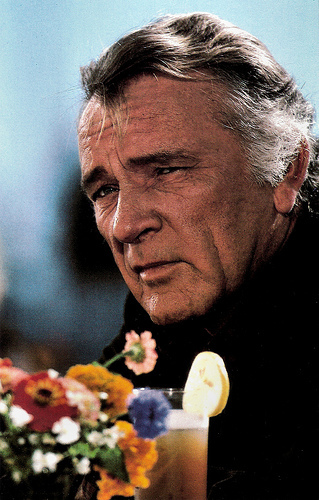
American postcard by Coral-Lee, Rancho Cordova, no. CL/Personality # 71. Photo: Douglas Kirkland, 1981.
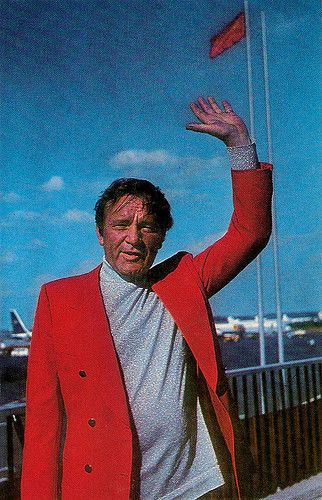
German postcard by WS-Druck, Wanne-Eickel, no 226.
Trailer for Look Back In Anger (1959). Source: ChocolateFrogPrince (YouTube).
Trailer for Cleopatra (1963). Source: DameElizabethTaylor (YouTube).
Sources: Brian McFarlane (Encyclopedia of British Cinema), Hal Erickson (AllMovie), Kit and Morgan Benson (Find A Grave), TCM, Wikipedia and .

French postcard by ISV / Huit, no. B 9. Photo: 20th Century Fox. Publicity still for Sea Wife (Bob McNaught, 1957).

Spanish postcard by Postalcolor, Barcelona, no. 35, 1963.

Spanish postcard by Postal Oscarcolor, no. 118.
An impoverished Welsh living
Richard Burton was born Richard Walter Jenkins in the village of Pontrhydyfen, Wales in 1925. He was the twelfth of thirteen children. His father, Richard Walter Jenkins, was a short, robust coal miner, a ‘twelve-pints-a-day man’.
Burton was less than two years old in 1927 when his mother, Edith Maude (née Thomas), died at the age of 43 after giving birth to her 13th child. His sister Cecilia ‘Cis’ and her husband Elfed took him into their Presbyterian mining family in nearby Port Talbot (an English-speaking steel town). He grew up speaking Cymraeg (Welsh) as well as English. His 19 year older brother Ifor became his de facto father figure, and in later years, his assistant and boon companion.
Burton showed a talent for English and Welsh literature at grammar school, and demonstrated an excellent memory, though his consuming interest was sports – rugby. He earned pocket money by running messages, hauling horse manure, and delivering newspapers. He started to smoke at the age of eight and to drink regularly at twelve. He believed that the way out of an impoverished Welsh living was to read, and he was always reading books.
Inspired by his schoolmaster, Philip H. Burton, he excelled in school productions, his first being The Apple Cart. The young man had spoken no English until the age of ten. Burton taught him to speak English without a Welsh accent, to read the classics, and to hold a knife and fork. Richard left school at sixteen for full-time work. He worked for the local wartime co-operative committee, handing out supplies in exchange for coupons, but then considered other professions for his future, including boxing, religion and singing.
When Jenkins joined the Port Talbot Squadron of the Air Training Corps as a cadet, he re-encountered Philip Burton, his former teacher, who was the commander. Burton rigorously schooled him in both literature and acting, even sending him to Welsh mountaintops to work on voice projection. After receiving his school certificate, Richard was accepted to Exeter College at Oxford for a special term of study. In order to gain admittance as an undergraduate, Philip Burton was required to adopt the young man; after discovering that it was legally impossible to do so, he made Richard his ward, and changed his surname to Burton.
Before leaving for Exeter, Burton made his professional acting debut in the play The Druid's Rest in 1944. The show was successful enough to move to London, where he received his first positive review in the New Statesman magazine. Those words would solidify Burton's resolve to become an actor.
While at Exeter, he appeared in his first significant Shakespearean role - Angelo in Measure for Measure - before an audience that included such important theatrical figures as John Gielgud and Terence Rattigan. Subsequently he served in the RAF (1944–1947) as a navigator. In 1947, after his discharge, Burton went to London to seek his fortune. He immediately signed up with a theatrical agency to make himself available for casting calls. His first film was The Last Days of Dolwyn (Russell Lloyd, Emlyn Williams, 1949), set in a Welsh village about to be drowned to provide a reservoir.

British postcard in the Shakespeare Memorial Theatre series, no. 18. Photo: Angus McBean. Richard Burton as Prince Hal in the stage production of Henry IV, Part I and Henry IV, Part 2, Stratford-upon-Avon, 1951.
He met his future wife, the young actress Sybil Williams, on the set, and they married in 1949. They had two daughters, and divorced in 1963 after Burton's widely reported affair with Elizabeth Taylor . In the years of his marriage to Sybil, Burton appeared in the West End in a highly successful production of The Lady's Not for Burning, alongside Sir John Gielgud and Claire Bloom , in both the London and New York productions.

British postcard in the Picturegoer series, London, no. W 912. Photo: British Lion.

Danish postcard by Kaj Brammers Boghandel, Helsingor, no. 748. Photo: publicity still for the stage production of Hamlet at the Hamletspillene in Kronborg, 1954. Richard Burton as Hamlet and Claire Bloom as Ophelia.

German postcard by WS-Druck, Wanne-Eickel, no 226. Offered by Macaroni Honig, Gent (Belgium). Photo: Centfox.

British postcard in the Film Star Autograph Portrait series by Celebrity Publishers, London, no. 79.
A Watchful Brooding Intensity
Richard Burton had small parts in various low-key British films: Now Barabbas (Gordon Parry, 1950) starring Richard Greene , Waterfront (Michael Anderson, 1950) with Robert Newton, The Woman with No Name (Ladislao Vajda, 1951) featuring Phyllis Calvert , and a bigger part as a smuggler in the B-film Green Grow the Rushes (Derek N. Twist, 1951). He displayed a watchful brooding intensity in these films.
In the 1951 season at Stratford, he gave a critically acclaimed performance and achieved stardom as Prince Hal in Shakespeare's Henry IV, Part 1 opposite Anthony Quayle's Falstaff. Burton was already demonstrating the same independence and competitiveness as an actor that he displayed off-stage in drinking, sport, or story-telling. He was admitted to the post-War British acting circle which included Anthony Quayle, John Gielgud , Michael Redgrave , Hugh Griffith and Paul Scofield.
The following year, Burton signed a five-year contract with Alexander Korda at £100 a week, launching his Hollywood career. On the recommendation of Daphne du Maurier, he was given the leading role in the mystery-romance My Cousin Rachel (Henry Koster, 1952) opposite Olivia de Havilland. Burton arrived on the Hollywood scene at a time when the studios were struggling. Television's rise was drawing away viewers and the studios looked to new stars and new film technology to staunch the bleeding. 20th Century Fox negotiated with Korda to borrow him for this film and a further two at $50,000 a film. My Cousin Rachel was a critical success. It established Burton as a Hollywood leading man and won him his first Academy Award nomination and the Golden Globe Award for New Star of the Year – Actor.
In the wartime action-drama The Desert Rats (Robert Wise, 1953), Burton plays a young English captain in the North African campaign during World War II who takes charge of a hopelessly out-numbered Australian unit against the indomitable Field Marshal Erwin Rommel ( James Mason ). Then he created a sensation by starring in the biblical epic The Robe (Henry Koster, 1953), the first film to premiere in the wide-screen process CinemaScope. The film was a colossal hit, it gave Burton his second Oscar nomination, and minted him as a genuine movie star.
Burton was offered a seven-year, $1 million contract by Darryl F. Zanuck at Fox, but he turned it down, though later the contract was revived and he agreed to it. Between 1953 and 1956, he was juggling theatre with film, playing Hamlet and Coriolanus at the Old Vic theatre and alternating the roles of Iago and Othello with the Old Vic's other rising matinee idol John Neville. For his Henry V he won the Evening Standard drama award.
Known for his resonant voice he also gave frequent readings of classic works on BBC Radio. In 1954, Burton took his most famous radio role, as the narrator in the original production of Dylan Thomas' Under Milk Wood, a role he would reprise in the film version twenty years later.
Burton appeared on Broadway, receiving a Tony Award nomination for Time Remembered (1958) and winning the award for playing King Arthur in the musical Camelot (1960). The latter show went on to run for over 800 performances, and netted a total of four Tony Awards. He then put his stage career on the back burner to concentrate on film.

French postcard. Photo: publicity still for The Robe (1953) with Jean Simmons .

German postcard by Kolibri-Verlag G.m.b.H., Minden/Westf., no. 2395. Photo: United Artists. Publicity still for Alexander the Great (1956).

Italian postcard by B.F.F. Edit. (Ballerini & Fratini, Firenze), no. 2507. Photo: 20th Century Fox. Publicity still for Sea Wife (Bob McNaught, 1957).

West-German postcard by Ufa, Berlin-Tempelhof, no. FK 4738. Photo: Terb-Agency.

West-German postcard by Rüdel Verlag, Hamburg-Bergedorf, no 1453. Photo: 20th Century Fox.
Liz and Dick
In terms of critical success, Richard Burton's Hollywood roles throughout the 1950s did not live up to the early promise of his debut. Burton returned to Hollywood to star in The Prince of Players (Philp Dunne, 1955), another historical CinemaScope film, this time concerning Edwin Booth, famous American actor and brother of Abraham Lincoln's assassin John Wilkes Booth.
Next came Alexander The Great (Robert Rossen, 1956), with the handsome and self-assured Burton in the title role, on a loan out to United Artists, and again with Claire Bloom co-starring. Contrary to Burton's expectations, the ‘intelligent epic’ was a wooden, slow-paced flop.
In The Rains of Ranchipur (Jean Negulesco, 1955) Burton plays a noble Hindu doctor who attempts the spiritual recovery of an adulteress (Lana Turner). In Sea Wife (Bob McNaught, 1957), shot in Jamaica, a young Joan Collins plays a nun shipwrecked on an island with three men.
For the British cinema the late 1950s was an exciting and inventive time, often referred to as the British New Wave, and Burton was right in the thick of things. In 1958, he was offered the part of Jimmy Porter, ‘an angry young man’ role, in the film version of John Osborne's play Look Back in Anger (Tony Richardson, 1959).
Hal Erickson writes at AllMovie : “His own film greatness would not manifest itself until he played the dirt-under-the-nails role of Jimmy Porter in Look Back in Anger (1959). In this, he spoke the vernacular of regular human beings - rather than that of high-priced, affected Hollywood screenwriters - and delivered a jolting performance as a working-class man trapped by the system and his own personal demons.” Although it didn't do well commercially, Burton was proud of the effort.
After playing King Arthur in Camelot on Broadway for six months, Burton was one of the ‘42 international stars’ that appeared in the massive World War II epic The Longest Day (Ken Annakin, Andrew Marton, Bernhard Wicki, 1962).
And then he replaced Stephen Boyd as Mark Antony in the troubled production Cleopatra (Joseph L. Mankiewicz, 1963). Twentieth Century Fox's future appeared to hinge on what became the most expensive movie ever made up until then. During the filming, Burton met and fell in love with Elizabeth Taylor , who was married to Eddie Fisher. Such was the scandal surrounding the Burton-Taylor romance that the U.S. State Department was requested to revoke Burton's visa on grounds that he was ‘detrimental to the morals of the youth of our nation.’
The tidal wave of press about the very public affair only helped to bring the curious public to theatres, which made it the highest grossing film of the year - though still a financial disaster, since its $26 million in ticket sales could never cover its price tag (an estimated $40 million). Cleopatra proved to be the start of Burton's most successful period in Hollywood; he would remain among the top 10 box-office earners for the next four years.
He and Taylor would not be free to marry until 1964 when their respective divorces were complete. Their marriage was the start of a series of on-screen collaborations. In the first, The V.I.P.s (Anthony Asquith, 1964), Burton played a husband who tries to prevent his wife (Taylor) from leaving to join her lover ( Louis Jourdan ) in the VIP lounge of London Airport. It proved to be a box-office hit.
Liz and Dick, as they were known, lived on a grand scale. He bought her jewels, including a 69-carat Cartier diamond. They bought a yacht for $500,000. Then he portrayed the archbishop martyred by Henry II in the title role of Becket (Peter Glenville, 1964), turning in an effective, restrained performance, contrasting with Peter O'Toole 's manic portrayal of Henry.
Burton triumphed as defrocked Episcopal priest Dr. T. Lawrence Shannon in Tennessee Williams' The Night of the Iguana (John Huston, 1964), a film which became another critical and box office success. Part of Burton's success in this film was due to how well he varied his acting with the three female characters, each of whom he tries to seduce differently: Ava Gardner (the randy hotel owner), Sue Lyon (the nubile American tourist), and Deborah Kerr (the poor, repressed artist).
He received a third Tony Award nomination when he reprised his Hamlet under John Gielgud's direction in 1964 in a production that holds the record for the longest run of the play in Broadway history (136 performances).

German postcard by Filmbilder-Vertrieb Ernst Freihoff, Essen, no. AX 5536. Photo: publicity still for Cleopatra (Joseph L. Mankiewicz, 1963) with Elizabeth Taylor .

Czech collectors card by Pressfoto, Praha (Prague), no. S 229/2 769. Set photo of Cleopatra (Joseph L. Mankiewicz, 1963) with Elizabeth Taylor and her children.

Czech postcard by UPTF Pressfoto, Praha (Prague), no. S 206/7. Photo: publicity still for Cleopatra (Joseph L. Mankiewicz, 1963) with Elizabeth Taylor .

Czech collectors card by Pressfoto, Praha (Prague), no. S 229/6 769, with Elizabeth Taylor .
Lush and rollicking
Richard Burton returned to the cinema as British spy Alec Leamas in The Spy Who Came in from the Cold (Martin Ritt, 1965). Burton and Taylor continued making films together though the next one, The Sandpiper (Vincente Minnelli, 1965), was poorly received.
Following that, he and Elizabeth Taylor were a great success in the film adaptation of the Edward Albee play Who's Afraid of Virginia Woolf? (Mike Nichols, 1966), in which a bitter erudite couple spend the evening trading vicious barbs in front of their horrified and fascinated guests, played by George Segal and Sandy Dennis. Burton was not the first choice for the role of Taylor's husband. Jack Lemmon was offered the role first, but when he backed off, Jack Warner, with Taylor's insistence, agreed on Burton and paid him his price. Although all four actors received Oscar nominations for their roles in the film (the film received a total of thirteen), only Taylor and Dennis went on to win.
Their lush and rollicking adaptation of Shakespeare's The Taming of the Shrew (Franco Zeffirelli, 1967), was a notable success. Later collaborations, however, The Comedians (Peter Glenville, 1967), Boom! (Joseph Losey, 1968), and the Burton-directed Doctor Faustus (Richard Burton, Nevill Coghill, 1967) (which had its genesis from a theatre production he staged and starred in at the Oxford University Dramatic Society) were critical and commercial failures.
He did enjoy a final commercial blockbuster with Clint Eastwood in Where Eagles Dare (Brian G. Hutton, 1968) but his last film of the decade, Anne of the Thousand Days (Charles Jarrott, 1969), was a commercial and critical disappointment. In spite of those failures, it performed remarkably well at that year's Academy awards (receiving ten nominations, including one for Burton's performance as Henry VIII), which many thought to be largely the result of an expensive advertising campaign by Universal Studios.
He was awarded the CBE (Commander of the Order of the British Empire) in the 1970 Queen's Birthday Honours List for his services to drama. He collected this award on his 45th birthday with his older sister Cis, who raised him as a child, and his wife Elizabeth Taylor . Due to Burton and Taylor's extravagant spending and his support of his family and others (42 people at one point), Burton agreed to work in mediocre films such as Bluebeard (Edward Dmytryk, Luciano Sacripanti, 1972) opposite Virna Lisi , Hammersmith Is Out (Peter Ustinov, 1972), and The Klansman (Terence Young, 1974) that hurt his career.
He recognised his financial need to do so, and that in the New Hollywood era of cinema he or Taylor would not soon again be paid as well as at the height of their stardom. The 1972 death of his brother Ifor cast him into a deep depression that brought his marriage to Taylor - once the gold standard for Hollywood unions - to an end in 1974.

French postcard by E.D.U.G., no. 254.

Spanish postcard by Postal Oscarcolor, no. 279. Photo: Publicity shot for Becket (Peter Glenville, 1964) with Peter O'Toole .

Israelian postcard by Editions de Luxe, no. 10.

Russian postcard by Izdanije Byuro Propogandy Sovietskogo Kinoiskusstva, 1975. (This postcard was printed in an edition of 200.000 cards.)
Critically Reviled Films
After twelve years, Richard Burton returned to the stage in 1976 in Equus. He replaced Anthony Perkins as psychiatrist Martin Dysart dealing with a young, sexually troubled patient. He won a special Tony Award for his appearance, although he had to make Exorcist II: The Heretic (John Boorman, 1977) before Hollywood producers would allow him to repeat his role in the film version, Equus (Sidney Lumet, 1977). For this role he won the Golden Globe Award as well as an Academy Award nomination. Public sentiment towards his perennial frustration at not winning an Oscar made many pundits consider him the favourite to finally win the award, but on Oscar Night he lost to Richard Dreyfuss in The Goodbye Girl.
In 1976 Burton received a Grammy in the category of Best Recording for Children for his narration of The Little Prince by Antoine de Saint-Exupéry. He also found success in 1978, when he narrated Jeff Wayne's Musical Version of The War of the Worlds. His distinctive performance became a necessary part of the concept album – so much so that a hologram of Burton is used to narrate the live stage show (touring in 2006, 2007, 2009 and 2010) of the musical.
Burton had an international box office hit with The Wild Geese (Andrew V. McLaglen, 1978), an adventure tale co-starring Roger Moore , Richard Harris and Stewart Granger as mercenaries in Africa. He returned to appearing in critically reviled films like The Medusa Touch (Jack Gold, 1978) opposite Lino Ventura , Circle of Two (Jules Dassin, 1980), and opposite Laurence Olivier as Wagner (Tony Palmer, 1983), a role he said he was born to play, after his success in Equus.
He died shortly after the filming of Michael Radford's adaptation of George Orwell's Nineteen Eighty-Four (1984) was completed. Burton played O'Brien, a sinister member of a totalitarian government who tortured John Hurt's low-ranking office worker for the crime of free thought. He was in terrible health during filming from years of alcoholism and heavy smoking, and had to wear a neck brace during rehearsals. His performance as O'Brien in the film was one of his most critically acclaimed performances, and as well as one of his most underplayed.
Richard Burton was nominated six times for an Academy Award for Best Actor and once for an Academy Award for Best Supporting Actor – but he never won. Richard Burton was married five times and he had four children. From 1949 until their divorce in 1963, he was married to producer Sybil Williams, by whom he had two daughters, actress Katherine ´Kate´ Burton (1957) and Jessica Burton (1961), who was diagnosed as profoundly autistic and would eventually be institutionalised. He was married twice, consecutively, to Elizabeth Taylor , from 1964 to 1974 and from 1975 to 1976. In 1964, the couple adopted a daughter from Germany, Maria Burton (1961). Burton also adopted Taylor's daughter by the late producer Mike Todd, Elizabeth Frances ´Liza´ Todd Burton (1957). In August 1976, a month after his second divorce from Taylor, Burton married model Susan Hunt, the former wife of Formula 1 Champion James Hunt; the marriage ended in divorce in 1982. From 1983 until his death in 1984, Burton was married to make-up artist Sally Hay.
Richard Burton died at age 58 from a brain haemorrhage in 1984 at his home in Céligny, Switzerland, and is buried there. Posthumously the television miniseries Ellis Island (Jerry London, 1984) was shown. It co-starred Richard with his daughter Kate Burton. Brian McFarlane concludes in the Encyclopedia of British Cinema : “In a wayward career, almost as famous for his drinking and his marriages, Burton would intermittently remind audiences of what he could do.”

American postcard by Coral-Lee, Rancho Cordova, no. CL/Personality # 71. Photo: Douglas Kirkland, 1981.

German postcard by WS-Druck, Wanne-Eickel, no 226.
Trailer for Look Back In Anger (1959). Source: ChocolateFrogPrince (YouTube).
Trailer for Cleopatra (1963). Source: DameElizabethTaylor (YouTube).
Sources: Brian McFarlane (Encyclopedia of British Cinema), Hal Erickson (AllMovie), Kit and Morgan Benson (Find A Grave), TCM, Wikipedia and .
Published on March 19, 2017 23:00
March 18, 2017
Imported from the USA: Adolphe Menjou
Suave and debonair American actor Adolphe Menjou (1890-1963) with his trademark waxy black moustache was one of Hollywood's most distinguished stars and one of America's 'Best Dressed Men'. He started as a matinee idol in the silent cinema in such classics as Ernst Lubitsch's The Marriage Circle (1924). His sound films included Morocco (1931) with Marlene Dietrich and Gary Cooper, A Star is Born (1937), and Stanley Kubrick's Paths of Glory (1957) with Kirk Douglas. In 1931, he was nominated for an Oscar for The Front Page (1931).
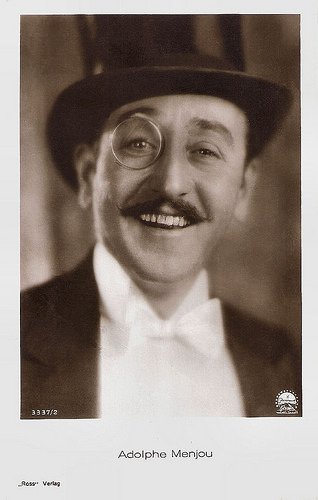
German postcard by Ross Verlag, no. 3337/2, 1928-1929. Photo: Paramount.
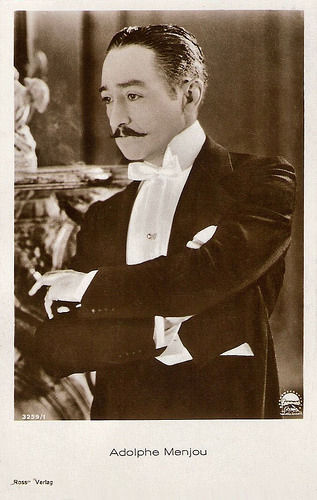
German postcard by Ross Verlag, no. 3259/1, 1928-1929. Photo: Paramount.
Urbane ladies' man and wealthy roué
Adolphe Jean Menjou was born in 1890 in Pittsburgh. He was the elder son of hotel manager Albert Menjou. His Irish mother, Nora Menjou-Joyce, was a distant cousin of the famous Irish author James Joyce. Menjou had a younger brother, Henri Menjou, who made an attempt to become an actor and played in three films for Paramount in the mid-1930s.
Their French émigré father moved the family to Cleveland, where he operated a chain of restaurants. He disapproved of show business and sent his son to Culver Military Academy in Indiana in the hopes of dissuading him from an acting career. Later, at Cornell University, Menjou abruptly changed his major engineering to liberal arts and began auditioning for college plays.
He did some vaudeville work, and from 1915 on, he appeared as an extra for such film studios as Vitagraph, Edison and Biograph. During World War I, he served as a captain with the Ambulance Corps in France. After the war he found employment off-camera as a production manager and unit manager.
After six years of struggle, he finally broke into the top ranks with substantial roles in The Faith Healer (George Melford, 1921) and Through the Back Door (Alfred E. Green, Jack Pickford, 1921), starring Mary Pickford. He earned a Paramount contract and played Louis XIII in The Three Musketeers (Fred Niblo, 1921), starring Douglas Fairbanks , and the influential writer Raoul de Saint Hubert in Rudolph Valentino's classic The Sheik (George Melford, 1921).
Menjou established his slick prototype as the urbane ladies' man and wealthy roué opposite Edna Purviance in Charlie Chaplin 's A Woman of Paris (1923). Paramount capitalised on Menjou's playboy image by casting him as matinee leads in Broadway After Dark (Monta Bell, 1924), Sinners in Silk (Hobart Henley, 1924), The Ace of Cads (Luther Reed, 1926), A Social Celebrity (Malcolm St. Clair, 1926) and A Gentleman of Paris (Harry d'Abbadie d'Arrast, 1927).
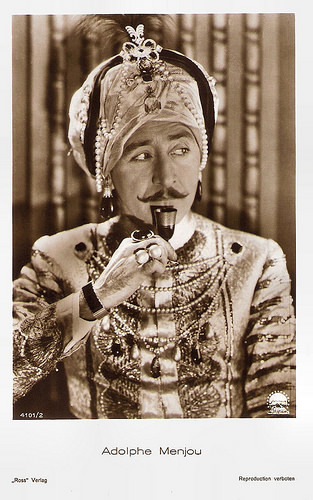
German postcard by Ross Verlag, no. 4101/2, 1929-1930. Photo: Paramount. Publicity still for His Tiger Wife (Hobart Henley, 1928).
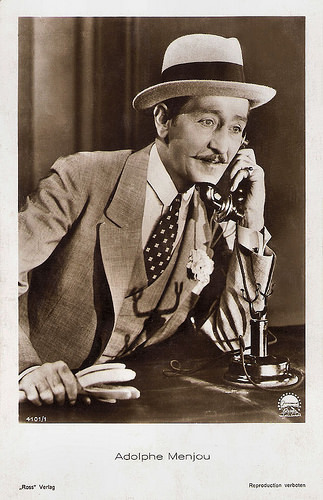
German postcard by Ross Verlag, no. 4101/1, 1929-1930. Photo: Paramount.
Rivalling Gary Cooper for the attentions of Marlene Dietrich
The stock market crash led to the termination of Adolphe Menjou's Paramount contract and his status as a leading man. Gary Brumburgh at IMDb : "MGM took him on at half his Paramount salary and his fluency in such languages as French and Spanish kept him employed at the beginning.
Rivalling Gary Cooper for the attentions of Marlene Dietrich in Morocco (1930) started the ball rolling for Menjou as a dressy second lead. Rarely placed in leads following this period, he managed his one and only Oscar nomination for Best Actor with his performance as editor Walter Burns in The Front Page (Lewis Milestone, 1931)."
Other successful films include Forbidden (Frank Capra, 1932), Little Miss Marker (Alexander Hall, 1934), A Star is Born (William A. Wellman, 1937), Stage Door (Gregory La Cava, 1937) and Golden Boy (Rouben Mamoulian, 1939).
During the war, he entertained the troops overseas and worked for the radio. He played the slick and slimy lawyer Billy Flynn opposite Ginger Rogers in Roxie Hart (William A. Wellman, 1942). After the war he played secondary parts in The Hucksters (Jack Conway, 1947) and State of the Union (Frank Capra, 1948).
His last lead was in the crackerjack thriller The Sniper (Edward Dmytryk, 1952). His role was a San Francisco homicide detective tracking down a killer who preys on women in San Francisco. For the first time in nearly two decades, he appeared without his moustache.
In 1947, Menjou cooperated with the House Committee on Un-American Activities in its hunt for communists in Hollywood. Menjou was a leading member of the Motion Picture Alliance for the Preservation of American Ideals, a group formed to oppose communist influence in Hollywood.
His last notable film was the classic anti-war picture Paths of Glory (Stanley Kubrick, 1957) in which he played the villainous General Broulard. After Disney's Pollyanna (David Swift, 1960), featuring Hayley Mills , he retired from acting.
In 1963, he died in his home in Beverly Hills after a nine-month battle with hepatitis. He married three times. His second wife was actress and co-star Kathryn Carver. They married in 1928 and divorced in 1934. Since 1934 he was married to actress Verree Teasdale, with whom he had an adopted son, Peter. His autobiography was called It Took Nine Tailors (1947).
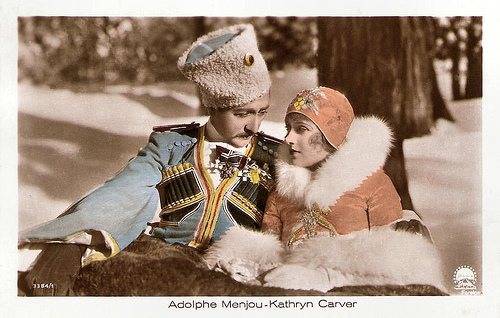
British Real Hand-Coloured Photograph postcard, no. 3384/1. Photo: Paramount. Publicity still for Service for Ladies (Harry d'Abbadie d'Arrast, 1927) with Kathryn Carver.
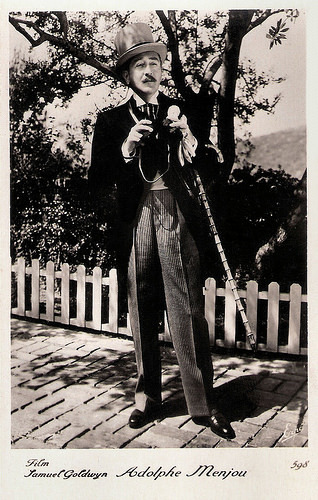
French postcard by Erpé, no. 398. Photo: Film Samuel Goldwyn.
Sources: (IMDb), Wikipedia and .

German postcard by Ross Verlag, no. 3337/2, 1928-1929. Photo: Paramount.

German postcard by Ross Verlag, no. 3259/1, 1928-1929. Photo: Paramount.
Urbane ladies' man and wealthy roué
Adolphe Jean Menjou was born in 1890 in Pittsburgh. He was the elder son of hotel manager Albert Menjou. His Irish mother, Nora Menjou-Joyce, was a distant cousin of the famous Irish author James Joyce. Menjou had a younger brother, Henri Menjou, who made an attempt to become an actor and played in three films for Paramount in the mid-1930s.
Their French émigré father moved the family to Cleveland, where he operated a chain of restaurants. He disapproved of show business and sent his son to Culver Military Academy in Indiana in the hopes of dissuading him from an acting career. Later, at Cornell University, Menjou abruptly changed his major engineering to liberal arts and began auditioning for college plays.
He did some vaudeville work, and from 1915 on, he appeared as an extra for such film studios as Vitagraph, Edison and Biograph. During World War I, he served as a captain with the Ambulance Corps in France. After the war he found employment off-camera as a production manager and unit manager.
After six years of struggle, he finally broke into the top ranks with substantial roles in The Faith Healer (George Melford, 1921) and Through the Back Door (Alfred E. Green, Jack Pickford, 1921), starring Mary Pickford. He earned a Paramount contract and played Louis XIII in The Three Musketeers (Fred Niblo, 1921), starring Douglas Fairbanks , and the influential writer Raoul de Saint Hubert in Rudolph Valentino's classic The Sheik (George Melford, 1921).
Menjou established his slick prototype as the urbane ladies' man and wealthy roué opposite Edna Purviance in Charlie Chaplin 's A Woman of Paris (1923). Paramount capitalised on Menjou's playboy image by casting him as matinee leads in Broadway After Dark (Monta Bell, 1924), Sinners in Silk (Hobart Henley, 1924), The Ace of Cads (Luther Reed, 1926), A Social Celebrity (Malcolm St. Clair, 1926) and A Gentleman of Paris (Harry d'Abbadie d'Arrast, 1927).

German postcard by Ross Verlag, no. 4101/2, 1929-1930. Photo: Paramount. Publicity still for His Tiger Wife (Hobart Henley, 1928).

German postcard by Ross Verlag, no. 4101/1, 1929-1930. Photo: Paramount.
Rivalling Gary Cooper for the attentions of Marlene Dietrich
The stock market crash led to the termination of Adolphe Menjou's Paramount contract and his status as a leading man. Gary Brumburgh at IMDb : "MGM took him on at half his Paramount salary and his fluency in such languages as French and Spanish kept him employed at the beginning.
Rivalling Gary Cooper for the attentions of Marlene Dietrich in Morocco (1930) started the ball rolling for Menjou as a dressy second lead. Rarely placed in leads following this period, he managed his one and only Oscar nomination for Best Actor with his performance as editor Walter Burns in The Front Page (Lewis Milestone, 1931)."
Other successful films include Forbidden (Frank Capra, 1932), Little Miss Marker (Alexander Hall, 1934), A Star is Born (William A. Wellman, 1937), Stage Door (Gregory La Cava, 1937) and Golden Boy (Rouben Mamoulian, 1939).
During the war, he entertained the troops overseas and worked for the radio. He played the slick and slimy lawyer Billy Flynn opposite Ginger Rogers in Roxie Hart (William A. Wellman, 1942). After the war he played secondary parts in The Hucksters (Jack Conway, 1947) and State of the Union (Frank Capra, 1948).
His last lead was in the crackerjack thriller The Sniper (Edward Dmytryk, 1952). His role was a San Francisco homicide detective tracking down a killer who preys on women in San Francisco. For the first time in nearly two decades, he appeared without his moustache.
In 1947, Menjou cooperated with the House Committee on Un-American Activities in its hunt for communists in Hollywood. Menjou was a leading member of the Motion Picture Alliance for the Preservation of American Ideals, a group formed to oppose communist influence in Hollywood.
His last notable film was the classic anti-war picture Paths of Glory (Stanley Kubrick, 1957) in which he played the villainous General Broulard. After Disney's Pollyanna (David Swift, 1960), featuring Hayley Mills , he retired from acting.
In 1963, he died in his home in Beverly Hills after a nine-month battle with hepatitis. He married three times. His second wife was actress and co-star Kathryn Carver. They married in 1928 and divorced in 1934. Since 1934 he was married to actress Verree Teasdale, with whom he had an adopted son, Peter. His autobiography was called It Took Nine Tailors (1947).

British Real Hand-Coloured Photograph postcard, no. 3384/1. Photo: Paramount. Publicity still for Service for Ladies (Harry d'Abbadie d'Arrast, 1927) with Kathryn Carver.

French postcard by Erpé, no. 398. Photo: Film Samuel Goldwyn.
Sources: (IMDb), Wikipedia and .
Published on March 18, 2017 23:00
March 17, 2017
A new gift from Tatiana
Last week again a letter arrived from the USA. It contained vintage material of Ukrainian-born silent film star Xenia Desni and of her beautiful daughter
Tamara Desni
. It was sent to me as a gift by their niece Tatiana, the daughter of Xenia's sister who now lives at the East Coast. Earlier she has sent us a package containing 39 Ross Verlag postcards, which she had collected as a little girl. Later, she found more private photos, studio stills and a flyer in her family archive and donated it all to European Film Star Postcards. This time it is mainly material of Tamara Desni (1910–2008), who started her stage and film career as a child in Berlin, and appeared in several British films during the 1930s and 1940s. We're honoured and grateful for this new gift, and so happy we can share this unique material today with you.
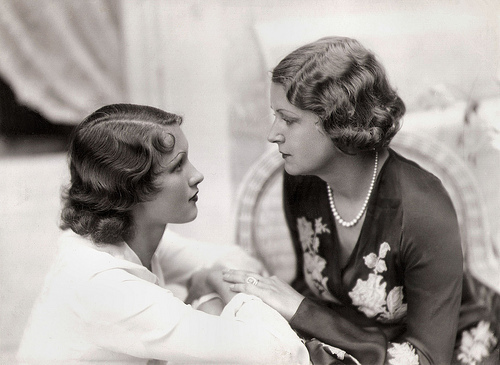
Photo of Tamara and Xenia Desni, ca. 1935.
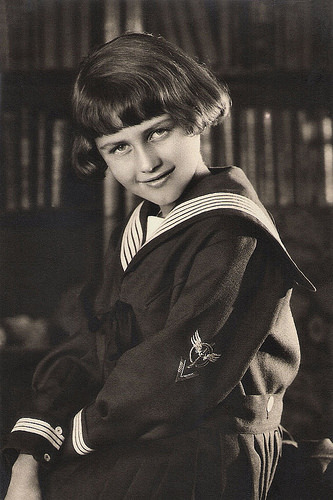
Photo of Tamara Desni , ca. 1920.
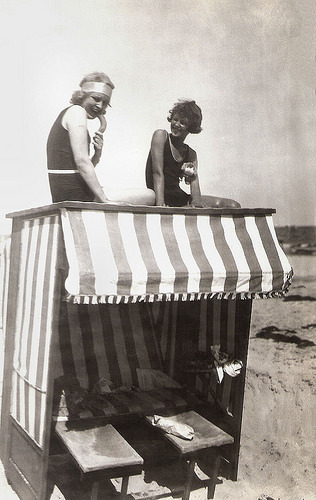
Photo of Xenia and Tamara having fun at the beach, early 1920s.
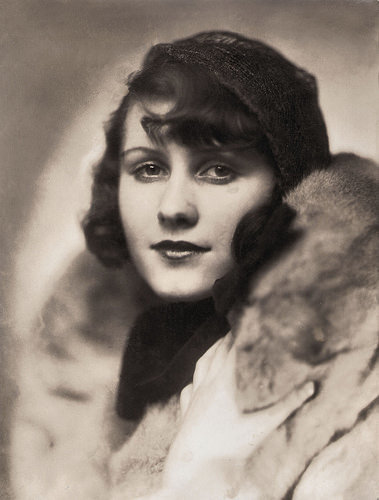
Photo of Tamara Desni by Otto Kurt Vogelsang, Berlin, 1930.
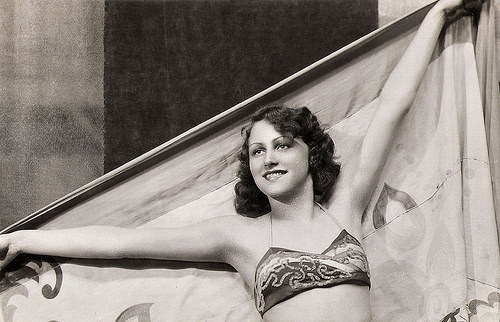
Photo of Tamara Desni as a young dancer, ca. 1930.
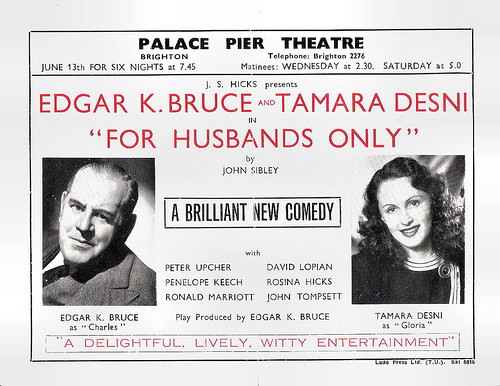
British flyer by Ludo Press Ltd. for Palace Pier Theatre, Brighton, 1949. Photos: publicity stills for the play For Husbands Only by John Sibley and starring Edgar K. Bruce and Tamara Desni .
Thank you so much, Tatiana!

Photo of Tamara and Xenia Desni, ca. 1935.

Photo of Tamara Desni , ca. 1920.

Photo of Xenia and Tamara having fun at the beach, early 1920s.

Photo of Tamara Desni by Otto Kurt Vogelsang, Berlin, 1930.

Photo of Tamara Desni as a young dancer, ca. 1930.

British flyer by Ludo Press Ltd. for Palace Pier Theatre, Brighton, 1949. Photos: publicity stills for the play For Husbands Only by John Sibley and starring Edgar K. Bruce and Tamara Desni .
Thank you so much, Tatiana!
Published on March 17, 2017 23:00
March 16, 2017
Gino Cervi
Gino Cervi (1901-1974) was one of the most popular Italian character actors of the 20th Century. He was highly active between the 1920s and the 1970s, first on stage, then on screen and finally on television. Internationally he is best remembered as the Communist mayor Peppone in the Don Camillo films and as Commissioner Maigret in the RAI TV series.

Mexican Collectors card, no. 327.

Italian postcard by S.A. Grafitalia, Milano (Milan), no. 4. Photo: Film Lux. Publicity still for I Promessi Sposi/The Spirit and the Flesh (Mario Camerini, 1941). Left to right Dina Sassoli as Lucia, Gino Cervi as Renzo, on the back Gilda Marchiò as Agnese, and Luis Hurtado as Padre Cristoforo.

Italian postcard by B.F.F. Edit, no. 4648-A. Photo: Pesce / N.I.C.

Italian postcard by Ed. Riservata Chiesa Parocchiale di Brescello. Promotion card for the village of Brescello (Reggio Emilia), where the Don Camillo films were shot. Here Fernandel as the catholic priest Don Camillo and Gino Cervi as the communist mayor Peppone.
A Cherished All-round Actor
Gino Cervi was born Luigi Cervi in Bologna, Italy in 1901. He was the son of literary critic Antonio Cervi. Gino was stage struck from an early age on.
In 1924 he debuted on stage with Alda Borelli in La vergine folle, a play by Henry Bataille, directed by Henri Diamant-Berger. In 1928 he married Angela Rosa (Nini) Gordini, one of his colleagues, and they had a son Antonio, the later director and producer Tonino Cervi.
Gino Cervi became more and more popular and became first actor at the Tofano-Maltagliati company (1935-1937). His deep and suggestive voice and his extreme versatility made him a cherished all-round actor, famous for his Othello. In 1938 he raised his own theatre company, with Andreina Pagnani, Rina Morelli, and Paolo Stoppa , connected with the Teatro Eliseo in Rome. In 1939 he became director of this theatre. His portrayals of Feste in Twelfth Night (1938) and Falstaff in The Merry Wives of Windsor (1939) established him as the foremost Italian comedian in classic roles.
In the early 1930s Cervi had made his screen debut in a film on the Air Force. Immediately demonstrating his versatility, he appeared in Mario Camerini's melancholic love story T'amerò sempre/I Will Always Love You (1933).
But it was in the late 1930s that he came to the foreground as a film actor thanks to director Alessandro Blasetti, who had him perform in such historical epics as Ettore Fieramosca (Alessandro Blasetti, 1938), Un’avventura di Salvator Rosa/An Adventure of Salvator Rosa (Alessandro Blasetti, 1939) and La corona di ferro/The Iron Crown (Alessandro Blasetti, 1941) with Massimo Girotti as his son.
Blasetti recognized Cervi's range and cast him in the role of the plain, downtrodden traveling salesman in his neorealist precursor Quattro passi fra le nuvole/A Walk in the Clouds (Alessandro Blasetti, 1942). Cervi pretends to be the husband of a pregnant, unmarried girl (Adriana Benetti), just to help her out. It was the first of his films to be shown widely outside Italy.
Elaine Mancini at Film Reference: "His performance in one scene of a little-known film, La Peccatrice/The Sinner (Amleto Palermi, 1940), is a tour de force that represents Cervi's combination of technical virtuosity and naturalness. He plays a cad living in a small town; a person he has victimized, the 'sinner' of the title, has returned to the town after several years and watches him eating alone in a restaurant. In this scene he must express the cad's entire character — his disregard for others, his lack of conscience, his pomposity — simply by eating his meal."
For decades, Cervi was also the Italian voice for various American actors, such as Laurence Olivier and Orson Welles in their Shakespearian films, Clark Gable in It happened one night (Frank Capra, 1934), James Mason in Pandora (Albert Lewin, 1950), James Stewart in Harvey (Henry Koster, 1950) and Michael Redgrave in Morning Becomes Electra (1947, Dudley Nichols).
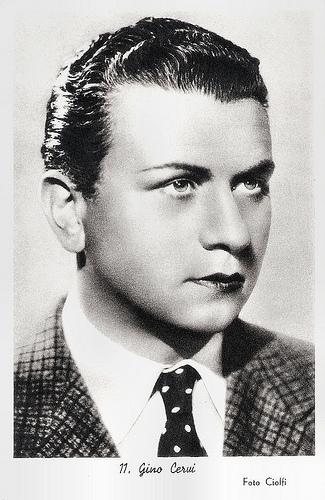
Italian postcard, no. 11. Photo: Ciolfi.
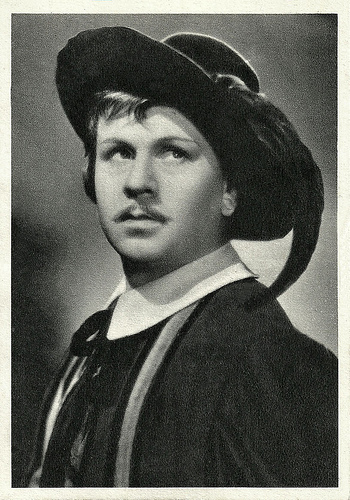
Italian postcard by S.A. Grafitalia, Milano (Milan), no. 10. Photo: Film Lux. Publicity still for I Promessi Sposi/The Spirit and the Flesh (1941, Mario Camerini) with Gino Cervi as Renzo Tramaglino.

Small West-German collectors card by Greiling Sammelbilder, Serie E, no. 103. Allianz-Film. Publicity still for Don Camillo (Julien Duvivier, 1952).
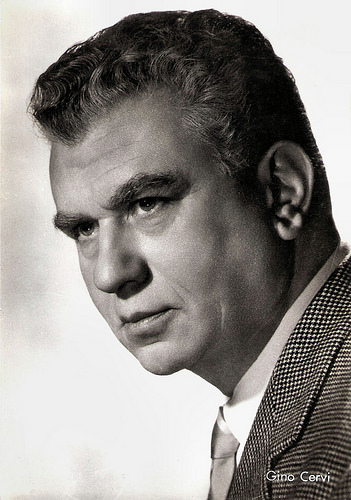
Italian postcard by Bromostampa, Milano, no. 291. Photo: Sam Lévin.
A Goodhearted But Sometimes Explosive Communist Mayor
After World War II, Gino Cervi continued to give credence to Italian costume dramas and historical epics in the cinema. On stage, he and the Eliseo company mounted Italian premieres of new foreign theatre works; his George in Jean Cocteau’s Les Parents terribles (Intimate Relations, 1945) and Hector in Jean Giraudoux’s Tiger at the Gates (1946) further enhanced his reputation. His outstanding theatrical accomplishment, however, was his portrayal of the title role in Cyrano de Bergerac (1953), an interpretation that was enthusiastically received, even in Paris.
In the 1950s Gino Cervi became a worldwide known film star as the goodhearted but sometimes explosive Communist mayor Giuseppe Bottazzi better known as Peppone, the antagonist of Fernandel’s hot-heated catholic priest Don Camillo.
Cervi and French comedian Fernandel co-starred in five films over a period of some 15 years, starting with Don Camillo/The Little World of Don Camillo (Julien Duvivier, 1952) and ending with Il compagno Don Camillo/Don Camillo in Moscow (Luigi Comencini, 1965). The films were based on the stories by Giovanni Guareschi, published from 1948 on – the first novel was The Little World of Don Camillo.
In the late 1950s and early 1960s Cervi played in several other comedies of the commedia all’italiana genre, such as Guardia, guardia scelta, brigadiere e maresciallo/Watch, select watch, sergeant and marshal (Mauro Bolognini, 1956) starring Alberto Sordi , Gli Anni ruggenti/Roaring Years ( Luigi Zampa, 1962) with Nino Manfredi , and Gli onorevoli/The Honorables (Sergio Corbucci, 1963) starring Totò , but he also played a memorable fascist leader in Florestano Vancini’s war film La lunga notte del ’43/It Happened in '43 (Florestano Vancini, 1960) starring Belinda Lee .
From the mid-1960s on, Cervi focused more on television. From 1964 to 1972, Cervi incarnated Georges Siménon’s Commissaire Jules Maigret in the RAI TV series Le inchieste del commissario Maigret. In this TV series Andreina Pagnani always played his wife. The series eventualy caused him also to play in a Maigret film for the big screen: Maigret a Pigalle (Mario Landi, 1966), produced by his own son, Tonino Cervi. The series were often repeated at RAI and had an intense second life through video and DVD as well. Siménon considered Cervi’s interpretation as one of the best.
In 1972 Cervi quitted acting. His last performances were for brandy commercials. Gino Cervi died in Punta Ala, Italy in 1974. Actress Valentina Cervi and producer Antonio Levesi Cervi are his grandchildren.

French postcard. Photo: Sam Lévin.

Italian postcard. Gino Cervi, Laura Adani, Paolo Carlini, and Graziella Granata in the Alan Ayckbourn stage comedy Relatively Speaking, retitled Sinceramente Bugiardi (Sincerely Liars, 1970), directed by Mario Ferrero, and played by the Compagnia di Prosa, led by Cervi.
Scene from Le retour de Don Camillo/The Return of Don Camillo (1953). Source: Kochlorber (YouTube).
Leader of Maigret a Pigalle (1966). Source: ShaolinTube (YouTube).
Sources: Elaine Mancini (Film Reference), Hal Erickson (AllMovie), (IMDb), Encyclopaedia Britannica, Wikipedia (French, Italian and English), and .

Mexican Collectors card, no. 327.

Italian postcard by S.A. Grafitalia, Milano (Milan), no. 4. Photo: Film Lux. Publicity still for I Promessi Sposi/The Spirit and the Flesh (Mario Camerini, 1941). Left to right Dina Sassoli as Lucia, Gino Cervi as Renzo, on the back Gilda Marchiò as Agnese, and Luis Hurtado as Padre Cristoforo.

Italian postcard by B.F.F. Edit, no. 4648-A. Photo: Pesce / N.I.C.

Italian postcard by Ed. Riservata Chiesa Parocchiale di Brescello. Promotion card for the village of Brescello (Reggio Emilia), where the Don Camillo films were shot. Here Fernandel as the catholic priest Don Camillo and Gino Cervi as the communist mayor Peppone.
A Cherished All-round Actor
Gino Cervi was born Luigi Cervi in Bologna, Italy in 1901. He was the son of literary critic Antonio Cervi. Gino was stage struck from an early age on.
In 1924 he debuted on stage with Alda Borelli in La vergine folle, a play by Henry Bataille, directed by Henri Diamant-Berger. In 1928 he married Angela Rosa (Nini) Gordini, one of his colleagues, and they had a son Antonio, the later director and producer Tonino Cervi.
Gino Cervi became more and more popular and became first actor at the Tofano-Maltagliati company (1935-1937). His deep and suggestive voice and his extreme versatility made him a cherished all-round actor, famous for his Othello. In 1938 he raised his own theatre company, with Andreina Pagnani, Rina Morelli, and Paolo Stoppa , connected with the Teatro Eliseo in Rome. In 1939 he became director of this theatre. His portrayals of Feste in Twelfth Night (1938) and Falstaff in The Merry Wives of Windsor (1939) established him as the foremost Italian comedian in classic roles.
In the early 1930s Cervi had made his screen debut in a film on the Air Force. Immediately demonstrating his versatility, he appeared in Mario Camerini's melancholic love story T'amerò sempre/I Will Always Love You (1933).
But it was in the late 1930s that he came to the foreground as a film actor thanks to director Alessandro Blasetti, who had him perform in such historical epics as Ettore Fieramosca (Alessandro Blasetti, 1938), Un’avventura di Salvator Rosa/An Adventure of Salvator Rosa (Alessandro Blasetti, 1939) and La corona di ferro/The Iron Crown (Alessandro Blasetti, 1941) with Massimo Girotti as his son.
Blasetti recognized Cervi's range and cast him in the role of the plain, downtrodden traveling salesman in his neorealist precursor Quattro passi fra le nuvole/A Walk in the Clouds (Alessandro Blasetti, 1942). Cervi pretends to be the husband of a pregnant, unmarried girl (Adriana Benetti), just to help her out. It was the first of his films to be shown widely outside Italy.
Elaine Mancini at Film Reference: "His performance in one scene of a little-known film, La Peccatrice/The Sinner (Amleto Palermi, 1940), is a tour de force that represents Cervi's combination of technical virtuosity and naturalness. He plays a cad living in a small town; a person he has victimized, the 'sinner' of the title, has returned to the town after several years and watches him eating alone in a restaurant. In this scene he must express the cad's entire character — his disregard for others, his lack of conscience, his pomposity — simply by eating his meal."
For decades, Cervi was also the Italian voice for various American actors, such as Laurence Olivier and Orson Welles in their Shakespearian films, Clark Gable in It happened one night (Frank Capra, 1934), James Mason in Pandora (Albert Lewin, 1950), James Stewart in Harvey (Henry Koster, 1950) and Michael Redgrave in Morning Becomes Electra (1947, Dudley Nichols).

Italian postcard, no. 11. Photo: Ciolfi.

Italian postcard by S.A. Grafitalia, Milano (Milan), no. 10. Photo: Film Lux. Publicity still for I Promessi Sposi/The Spirit and the Flesh (1941, Mario Camerini) with Gino Cervi as Renzo Tramaglino.

Small West-German collectors card by Greiling Sammelbilder, Serie E, no. 103. Allianz-Film. Publicity still for Don Camillo (Julien Duvivier, 1952).

Italian postcard by Bromostampa, Milano, no. 291. Photo: Sam Lévin.
A Goodhearted But Sometimes Explosive Communist Mayor
After World War II, Gino Cervi continued to give credence to Italian costume dramas and historical epics in the cinema. On stage, he and the Eliseo company mounted Italian premieres of new foreign theatre works; his George in Jean Cocteau’s Les Parents terribles (Intimate Relations, 1945) and Hector in Jean Giraudoux’s Tiger at the Gates (1946) further enhanced his reputation. His outstanding theatrical accomplishment, however, was his portrayal of the title role in Cyrano de Bergerac (1953), an interpretation that was enthusiastically received, even in Paris.
In the 1950s Gino Cervi became a worldwide known film star as the goodhearted but sometimes explosive Communist mayor Giuseppe Bottazzi better known as Peppone, the antagonist of Fernandel’s hot-heated catholic priest Don Camillo.
Cervi and French comedian Fernandel co-starred in five films over a period of some 15 years, starting with Don Camillo/The Little World of Don Camillo (Julien Duvivier, 1952) and ending with Il compagno Don Camillo/Don Camillo in Moscow (Luigi Comencini, 1965). The films were based on the stories by Giovanni Guareschi, published from 1948 on – the first novel was The Little World of Don Camillo.
In the late 1950s and early 1960s Cervi played in several other comedies of the commedia all’italiana genre, such as Guardia, guardia scelta, brigadiere e maresciallo/Watch, select watch, sergeant and marshal (Mauro Bolognini, 1956) starring Alberto Sordi , Gli Anni ruggenti/Roaring Years ( Luigi Zampa, 1962) with Nino Manfredi , and Gli onorevoli/The Honorables (Sergio Corbucci, 1963) starring Totò , but he also played a memorable fascist leader in Florestano Vancini’s war film La lunga notte del ’43/It Happened in '43 (Florestano Vancini, 1960) starring Belinda Lee .
From the mid-1960s on, Cervi focused more on television. From 1964 to 1972, Cervi incarnated Georges Siménon’s Commissaire Jules Maigret in the RAI TV series Le inchieste del commissario Maigret. In this TV series Andreina Pagnani always played his wife. The series eventualy caused him also to play in a Maigret film for the big screen: Maigret a Pigalle (Mario Landi, 1966), produced by his own son, Tonino Cervi. The series were often repeated at RAI and had an intense second life through video and DVD as well. Siménon considered Cervi’s interpretation as one of the best.
In 1972 Cervi quitted acting. His last performances were for brandy commercials. Gino Cervi died in Punta Ala, Italy in 1974. Actress Valentina Cervi and producer Antonio Levesi Cervi are his grandchildren.

French postcard. Photo: Sam Lévin.

Italian postcard. Gino Cervi, Laura Adani, Paolo Carlini, and Graziella Granata in the Alan Ayckbourn stage comedy Relatively Speaking, retitled Sinceramente Bugiardi (Sincerely Liars, 1970), directed by Mario Ferrero, and played by the Compagnia di Prosa, led by Cervi.
Scene from Le retour de Don Camillo/The Return of Don Camillo (1953). Source: Kochlorber (YouTube).
Leader of Maigret a Pigalle (1966). Source: ShaolinTube (YouTube).
Sources: Elaine Mancini (Film Reference), Hal Erickson (AllMovie), (IMDb), Encyclopaedia Britannica, Wikipedia (French, Italian and English), and .
Published on March 16, 2017 23:00
March 15, 2017
Mata Hari (1931)
On 14 October 2017, the Fries Museum in Leeuwarden will open an exhibition on exotic dancer and executed spy Mata Hari (1876-1917). The woman who was such an international society figure between 1905 and the First World War, was born in Leeuwarden as Margaretha Zelle. EFSP contributor Ivo Blom is one of the researchers for the exhibition. About his research he wrote two fascinating posts on his personal blog, of which we post two excerpts today in combination with postcards from the classic Hollywood biopic Mata Hari (George Fitzmaurice, 1931) starring Greta Garbo.
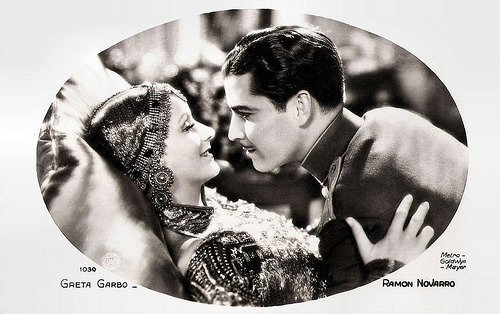
French postcard by EDUG, no. 1030. Photo: Metro-Goldwyn-Mayer / Clarence Sinclair Bull. Publicity still for Mata Hari (George Fitzmaurice, 1931) with Greta Garbo and Ramon Novarro .
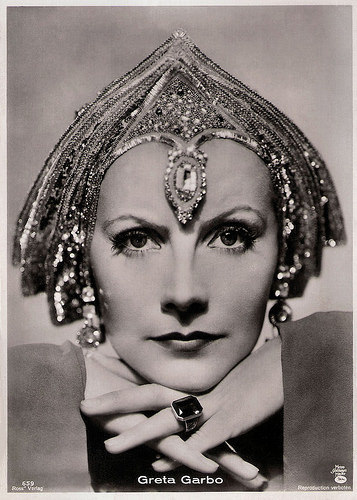
German postcard by Ross Verlag, no. 659. Photo: Metro-Goldwyn-Mayer / Clarence Sinclair Bull. Publicity still for Mata Hari (George Fitzmaurice, 1931) with Greta Garbo .
Researching a clip of a fashionable lady
Ivo Blom: "Still materials of Mata Hari are abundant: gorgeous coloured postcards, studio photos by prominents such as Emilio Sommariva, actuality photos etc., but what lacked were moving images. With a woman who was such a society figure between 1905 and the First World War, one asks himself why Pathé, Gaumont or any other prominent company did not film this woman, whose oriental dances had caused such a stir in Paris and beyond, and who was the mistress of many a prominent figure in politics, finance and culture?
Thus in films on her life or compilation films on the First World War a clip persisted of a fashionable lady helped in her coat by a doorman. She afterwards steps into a luxurious car with chauffeur and is driven away. This clip, coined as being with Mata Hari, has been used over and again as real footage with Mata Hari.
Even the respectable site EFG1914, supported and replenished by various European Film Archives, including the Dutch EYE, holds a compilation film that contains the same clip. It may be well have been the original culprit of the massive reuse and mythologization of ‘real’ film footage with Mata Hari. The compilation film uploaded by LUCE is the Italian version of 14-18 (1963) by French filmmaker Jean Aurel. The commentary states we notice Mata Hari here, helped into a taxi. The image quality was too poor to recognize any person. So where did Aurel did take it from? Could I get a better image quality?
Researching this clip was quite an adventure. I first contacted the CNC (Centre National pour la Cinématographie) near Paris, where Béatrice Paste kindly indicated me the compilation 14-18 by Aurel was a Gaumont production and CNC had recently digitized the film. Paste advised me to contact the Cinémathèque Gaumont. So I contacted curator Manuela Padoan who referred me to Nathalie Sitko, who proved to be an avid documentalist and helpful researcher.
In the meantime I searched myself on the site of Pathé-Gaumont-Archives. There I found the compilation documentary Paris après 3 ans de guerre (1917) by Gaumont, which contained the same clip, but now without any indication of Mata Hari. The description on the Gaumont site just said: ”Au pied d’un escalier, une femme élégante (bourgeoise) enfile son manteau aidé d’un maître d’hôtel, elle attend son véhicule et monte dans l’automobile.”
The film had been uploaded in HD, so the image quality was really good. Still, I had my doubts whether this was really the famous Mata Hari. My doubts proved to be right. Read on at Ivo Blom's blog."
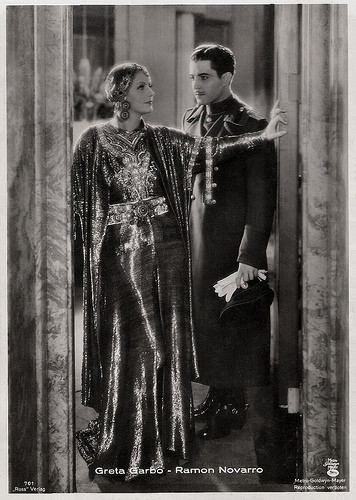
German postcard by Ross Verlag, no. 701. Photo: Metro-Goldwyn-Mayer / Clarence Sinclair Bull. Publicity still for Mata Hari (George Fitzmaurice, 1931).
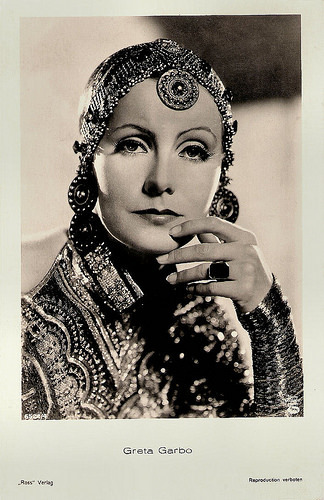
German postcard by Ross Verlag, no. 6522/4, 1931-1932. Photo: Metro-Goldwyn-Mayer / Clarence Sinclair Bull. Publicity still for Mata Hari (George Fitzmaurice, 1931).
Asta Nielsen and the Copy Cats
Ivo Blom: "In many analogue and digital sources a film entitled Mata Hari/Die Spionin (Ludwig Wolf, 1920/1921), starring Asta Nielsen , is listed as the oldest biopic of the life of Mata Hari aka Lady MacLeod aka Margaretha Zelle. You will find this on the Internet Movie Database (IMDb), which in general for German silent cinema is quite unreliable.
But one also traces it in the English and Dutch Wikipedia , James Monaco’s The Movie Guide, David Thompson’s The New Biographical Dictionary of Film, James Robert Parish’s Prostitution in Hollywood films, Jerry Vermilye’s More films from the thirties, Georg Seeßlen’s Filmwissen: Thriller: Grundlagen des populären Films and several earlier publications by the same author, Léon Schirmann’s Mata-Hari: autopsie d’une machination, Michael R. Pitts’s The Great Spies Pictures, Valeria Palumbo’s Le figlie di Lilith: vipere, dive, dark ladies e femmes fatales : l’altra ribellione femminile, Rüdiger Dirk and Claudius Sowa’s Paris im Film: Filmografie einer Stadt, and many others. The English Wikipedia even indicates Mata Hari (1920) and Die Spionin (1921) as two separate films, both about Mata Hari.
Nevertheless, my suspicions arose when I could not find the film on the generally quite thorough German films site www.filmportal.de. When I launched a call for more information on the Facebook site of Domitor, the network for researchers dealing with early cinema, my suspicions increased.
Joseph Juenger, Artistic Director at Stummfilm-Festival Karlsruhe, asked if I was really sure about this film. He could‘t find a film with the title Die Spionin, neither on the FIAF-CD nor in the 2010 two-volume extensive monography on Asta Nielsen by Heide Schlüpmann and Karola Gramann, nor on filmportal.de. Juenger remarked there was only a film with the title Die Rache der Spionin (1921), but the director was Richard Eicherg and Nielsen lacked.
I therefore contacted Asta Nielsen expert Heide Schlüpmann, who kindly told me despite her thorough research she never found a film with Nielsen called either Mata Hari or Die Spionin. It just seemed that all the above mentioned authors had just copied each other without bothering to check any original sources." Read on at Ivo Blom's blog..
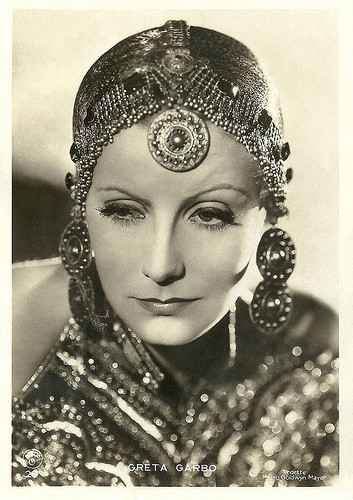
French postcard by Europe, no. 20. Photo: Metro-Goldwyn-Mayer / Clarence Sinclair Bull. Publicity still for Mata Hari (George Fitzmaurice, 1931).
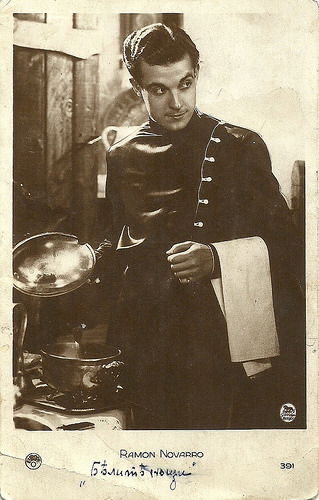
French postcard by Europe, no. 391. Photo: Metro-Goldwyn-Mayer / Clarence Sinclair Bull. Ramon Novarro as Lt. Alexis Rosanoff in Mata Hari (George Fitzmaurice, 1931).
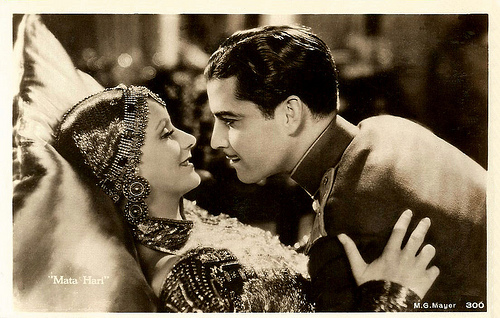
Dutch postcard, no. 300. Photo: Metro-Goldwyn-Mayer / Clarence Sinclair Bull. Publicity still for Mata Hari (George Fitzmaurice, 1931) with Greta Garbo and Ramon Novarro .
Thanks Ivo, for the permission to copy-cat your posts!

French postcard by EDUG, no. 1030. Photo: Metro-Goldwyn-Mayer / Clarence Sinclair Bull. Publicity still for Mata Hari (George Fitzmaurice, 1931) with Greta Garbo and Ramon Novarro .

German postcard by Ross Verlag, no. 659. Photo: Metro-Goldwyn-Mayer / Clarence Sinclair Bull. Publicity still for Mata Hari (George Fitzmaurice, 1931) with Greta Garbo .
Researching a clip of a fashionable lady
Ivo Blom: "Still materials of Mata Hari are abundant: gorgeous coloured postcards, studio photos by prominents such as Emilio Sommariva, actuality photos etc., but what lacked were moving images. With a woman who was such a society figure between 1905 and the First World War, one asks himself why Pathé, Gaumont or any other prominent company did not film this woman, whose oriental dances had caused such a stir in Paris and beyond, and who was the mistress of many a prominent figure in politics, finance and culture?
Thus in films on her life or compilation films on the First World War a clip persisted of a fashionable lady helped in her coat by a doorman. She afterwards steps into a luxurious car with chauffeur and is driven away. This clip, coined as being with Mata Hari, has been used over and again as real footage with Mata Hari.
Even the respectable site EFG1914, supported and replenished by various European Film Archives, including the Dutch EYE, holds a compilation film that contains the same clip. It may be well have been the original culprit of the massive reuse and mythologization of ‘real’ film footage with Mata Hari. The compilation film uploaded by LUCE is the Italian version of 14-18 (1963) by French filmmaker Jean Aurel. The commentary states we notice Mata Hari here, helped into a taxi. The image quality was too poor to recognize any person. So where did Aurel did take it from? Could I get a better image quality?
Researching this clip was quite an adventure. I first contacted the CNC (Centre National pour la Cinématographie) near Paris, where Béatrice Paste kindly indicated me the compilation 14-18 by Aurel was a Gaumont production and CNC had recently digitized the film. Paste advised me to contact the Cinémathèque Gaumont. So I contacted curator Manuela Padoan who referred me to Nathalie Sitko, who proved to be an avid documentalist and helpful researcher.
In the meantime I searched myself on the site of Pathé-Gaumont-Archives. There I found the compilation documentary Paris après 3 ans de guerre (1917) by Gaumont, which contained the same clip, but now without any indication of Mata Hari. The description on the Gaumont site just said: ”Au pied d’un escalier, une femme élégante (bourgeoise) enfile son manteau aidé d’un maître d’hôtel, elle attend son véhicule et monte dans l’automobile.”
The film had been uploaded in HD, so the image quality was really good. Still, I had my doubts whether this was really the famous Mata Hari. My doubts proved to be right. Read on at Ivo Blom's blog."

German postcard by Ross Verlag, no. 701. Photo: Metro-Goldwyn-Mayer / Clarence Sinclair Bull. Publicity still for Mata Hari (George Fitzmaurice, 1931).

German postcard by Ross Verlag, no. 6522/4, 1931-1932. Photo: Metro-Goldwyn-Mayer / Clarence Sinclair Bull. Publicity still for Mata Hari (George Fitzmaurice, 1931).
Asta Nielsen and the Copy Cats
Ivo Blom: "In many analogue and digital sources a film entitled Mata Hari/Die Spionin (Ludwig Wolf, 1920/1921), starring Asta Nielsen , is listed as the oldest biopic of the life of Mata Hari aka Lady MacLeod aka Margaretha Zelle. You will find this on the Internet Movie Database (IMDb), which in general for German silent cinema is quite unreliable.
But one also traces it in the English and Dutch Wikipedia , James Monaco’s The Movie Guide, David Thompson’s The New Biographical Dictionary of Film, James Robert Parish’s Prostitution in Hollywood films, Jerry Vermilye’s More films from the thirties, Georg Seeßlen’s Filmwissen: Thriller: Grundlagen des populären Films and several earlier publications by the same author, Léon Schirmann’s Mata-Hari: autopsie d’une machination, Michael R. Pitts’s The Great Spies Pictures, Valeria Palumbo’s Le figlie di Lilith: vipere, dive, dark ladies e femmes fatales : l’altra ribellione femminile, Rüdiger Dirk and Claudius Sowa’s Paris im Film: Filmografie einer Stadt, and many others. The English Wikipedia even indicates Mata Hari (1920) and Die Spionin (1921) as two separate films, both about Mata Hari.
Nevertheless, my suspicions arose when I could not find the film on the generally quite thorough German films site www.filmportal.de. When I launched a call for more information on the Facebook site of Domitor, the network for researchers dealing with early cinema, my suspicions increased.
Joseph Juenger, Artistic Director at Stummfilm-Festival Karlsruhe, asked if I was really sure about this film. He could‘t find a film with the title Die Spionin, neither on the FIAF-CD nor in the 2010 two-volume extensive monography on Asta Nielsen by Heide Schlüpmann and Karola Gramann, nor on filmportal.de. Juenger remarked there was only a film with the title Die Rache der Spionin (1921), but the director was Richard Eicherg and Nielsen lacked.
I therefore contacted Asta Nielsen expert Heide Schlüpmann, who kindly told me despite her thorough research she never found a film with Nielsen called either Mata Hari or Die Spionin. It just seemed that all the above mentioned authors had just copied each other without bothering to check any original sources." Read on at Ivo Blom's blog..

French postcard by Europe, no. 20. Photo: Metro-Goldwyn-Mayer / Clarence Sinclair Bull. Publicity still for Mata Hari (George Fitzmaurice, 1931).

French postcard by Europe, no. 391. Photo: Metro-Goldwyn-Mayer / Clarence Sinclair Bull. Ramon Novarro as Lt. Alexis Rosanoff in Mata Hari (George Fitzmaurice, 1931).

Dutch postcard, no. 300. Photo: Metro-Goldwyn-Mayer / Clarence Sinclair Bull. Publicity still for Mata Hari (George Fitzmaurice, 1931) with Greta Garbo and Ramon Novarro .
Thanks Ivo, for the permission to copy-cat your posts!
Published on March 15, 2017 23:00
Paul van Yperen's Blog
- Paul van Yperen's profile
- 13 followers
Paul van Yperen isn't a Goodreads Author
(yet),
but they
do have a blog,
so here are some recent posts imported from
their feed.



